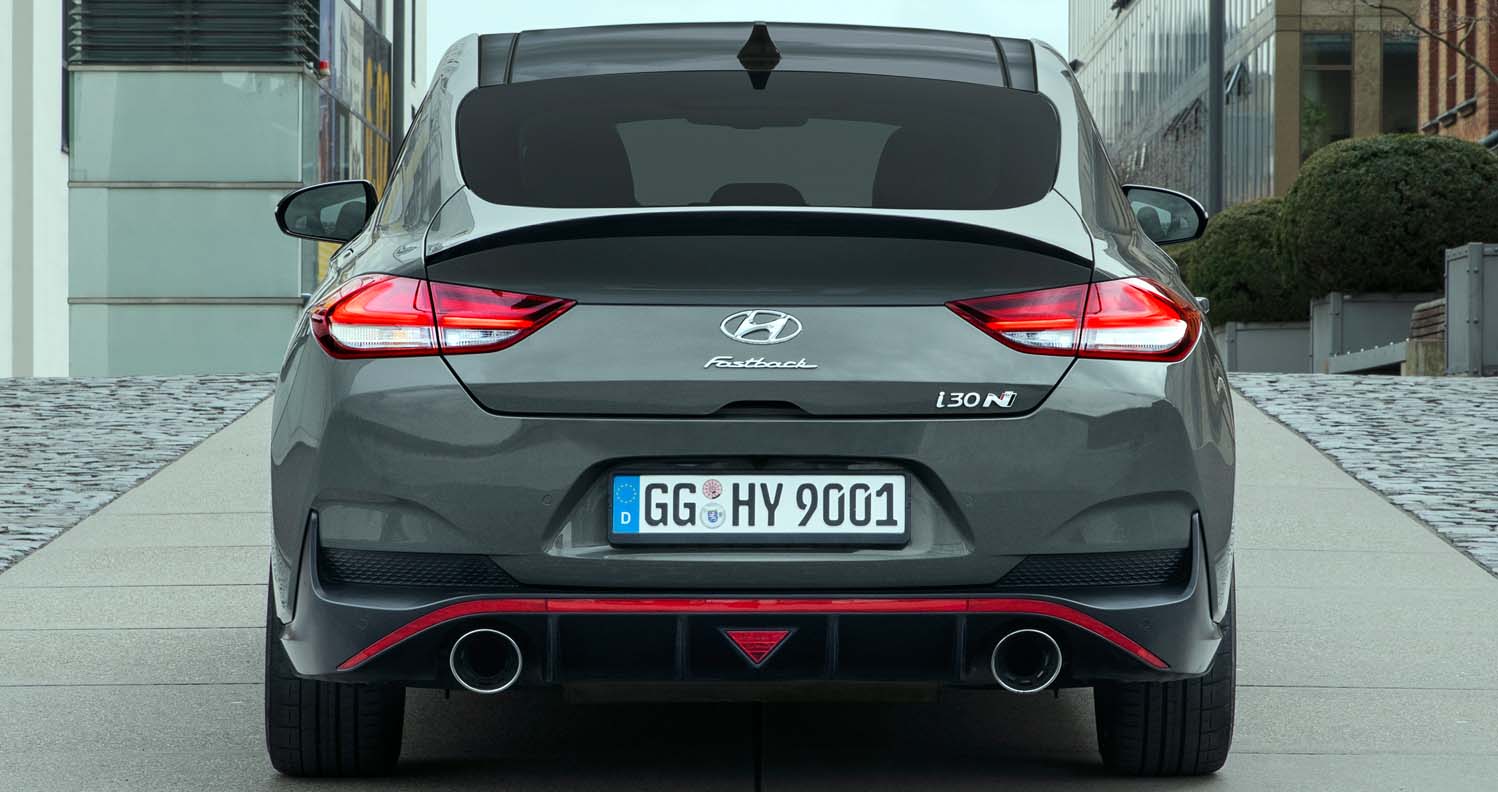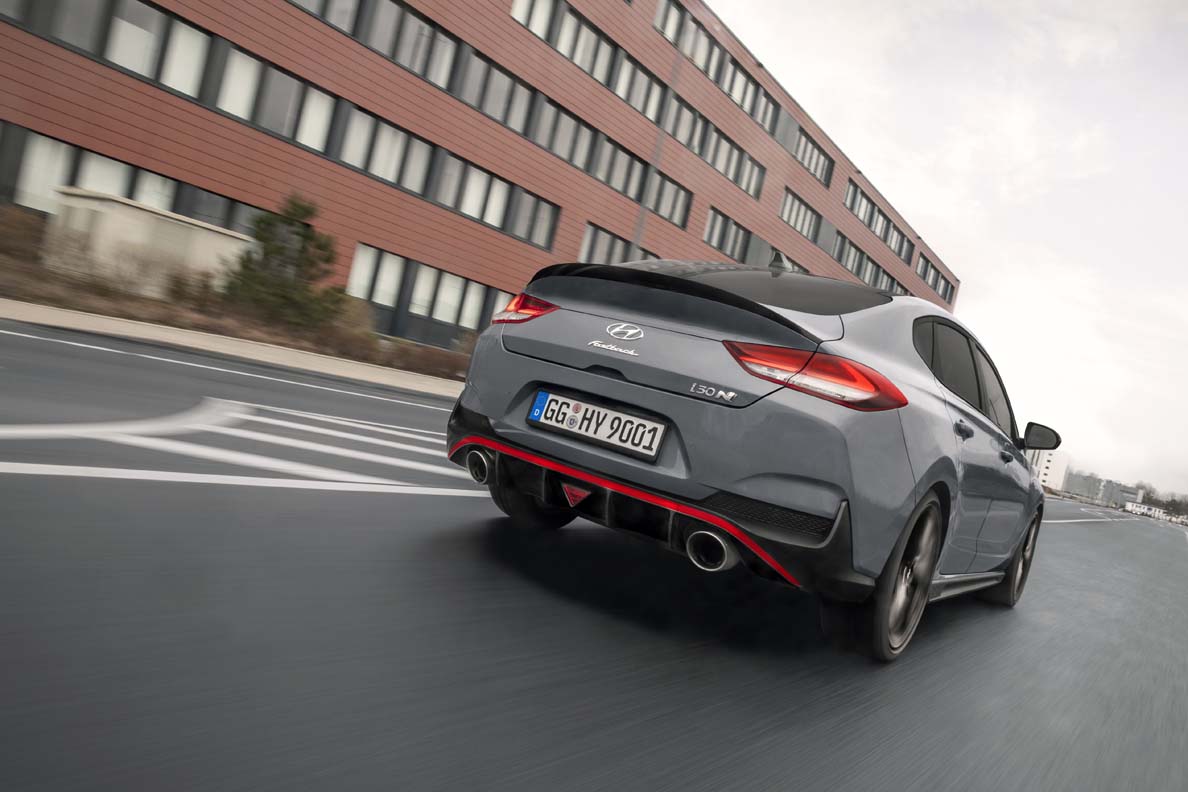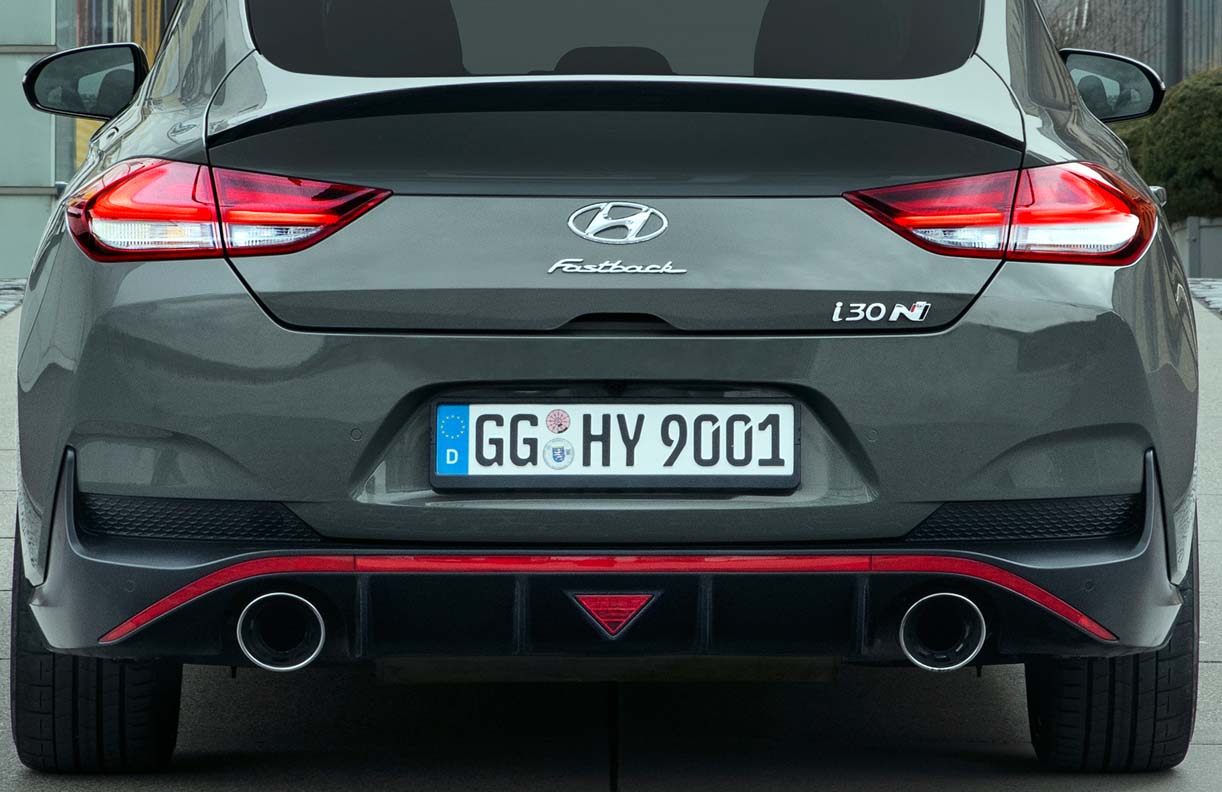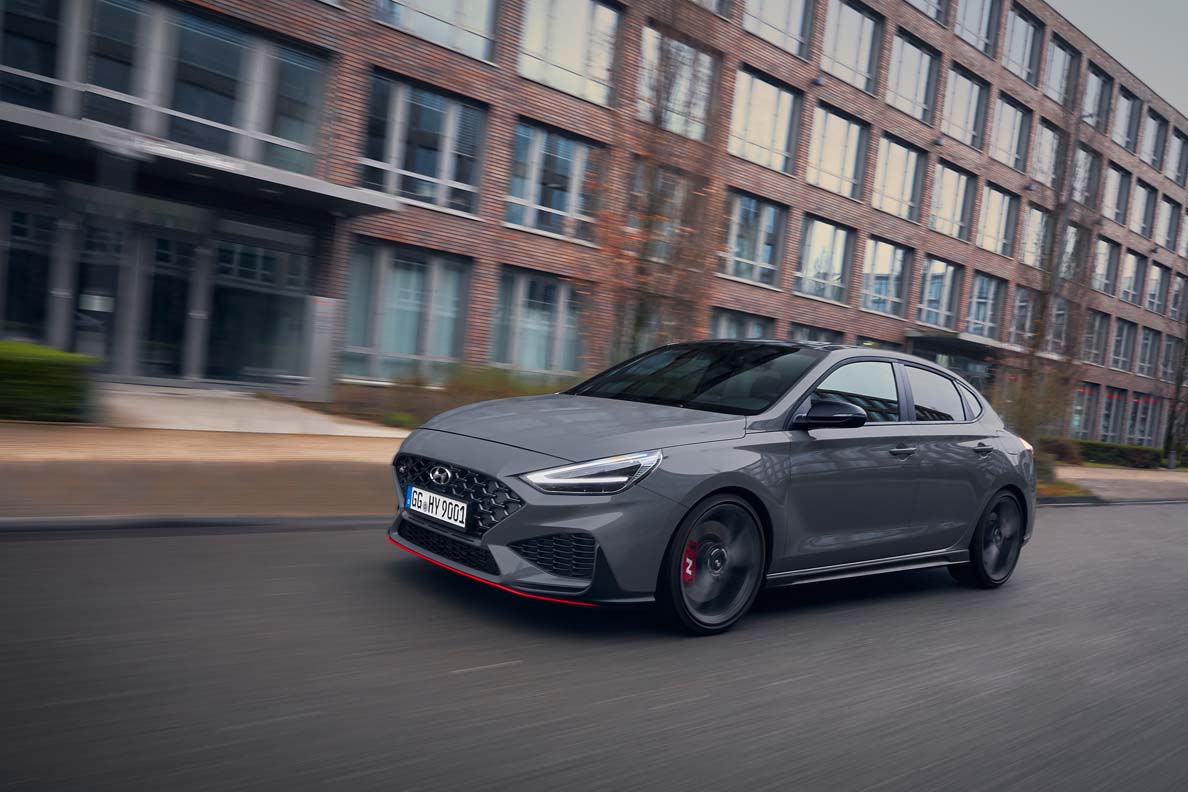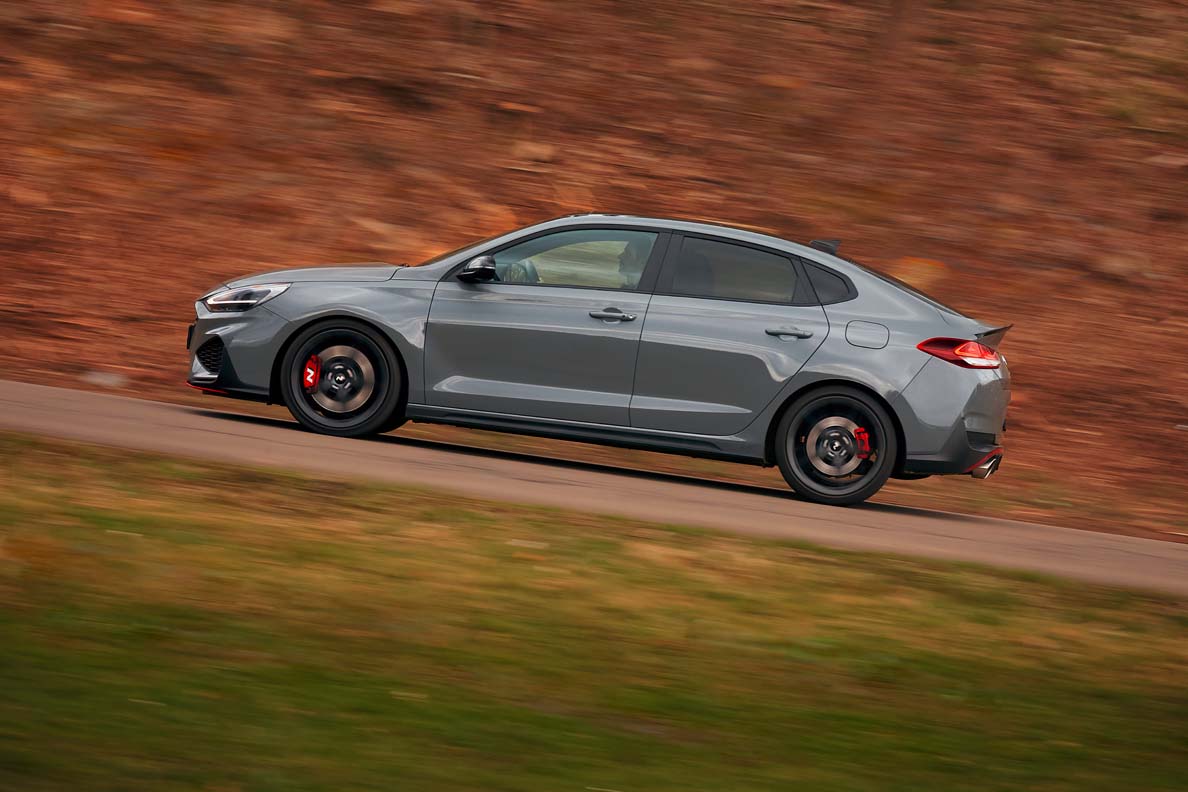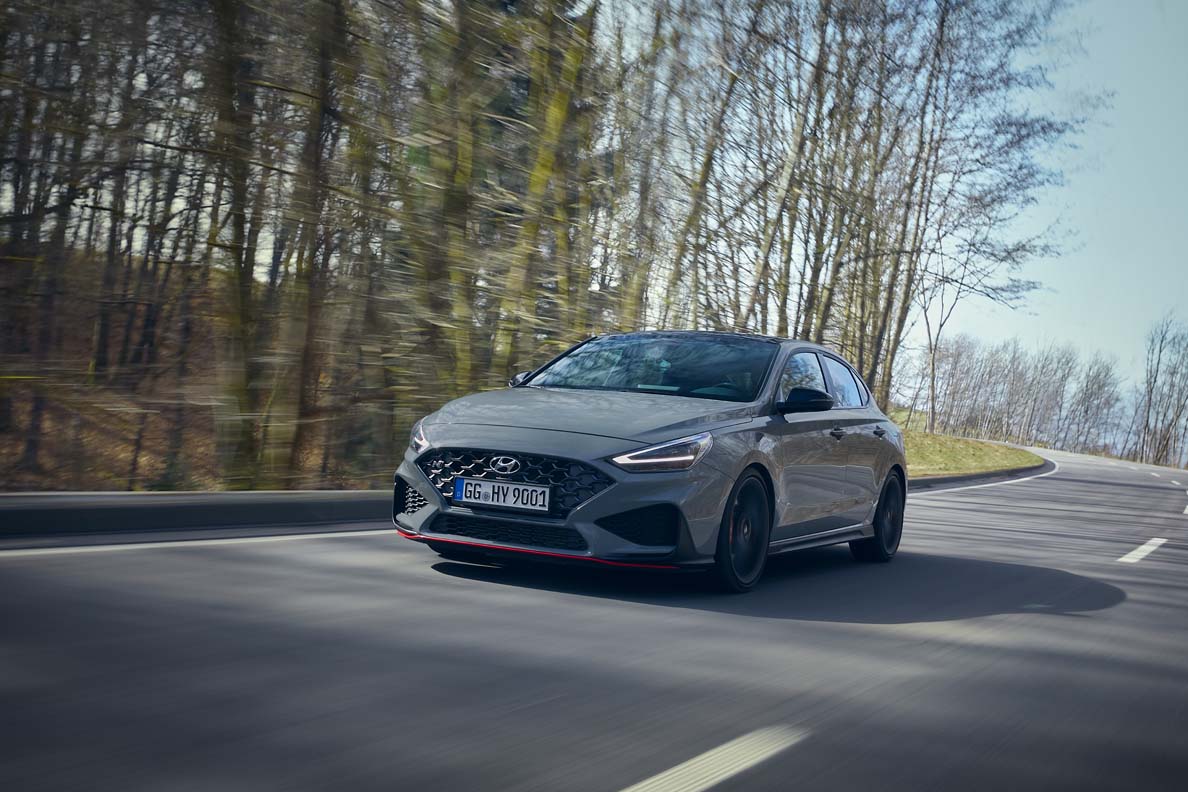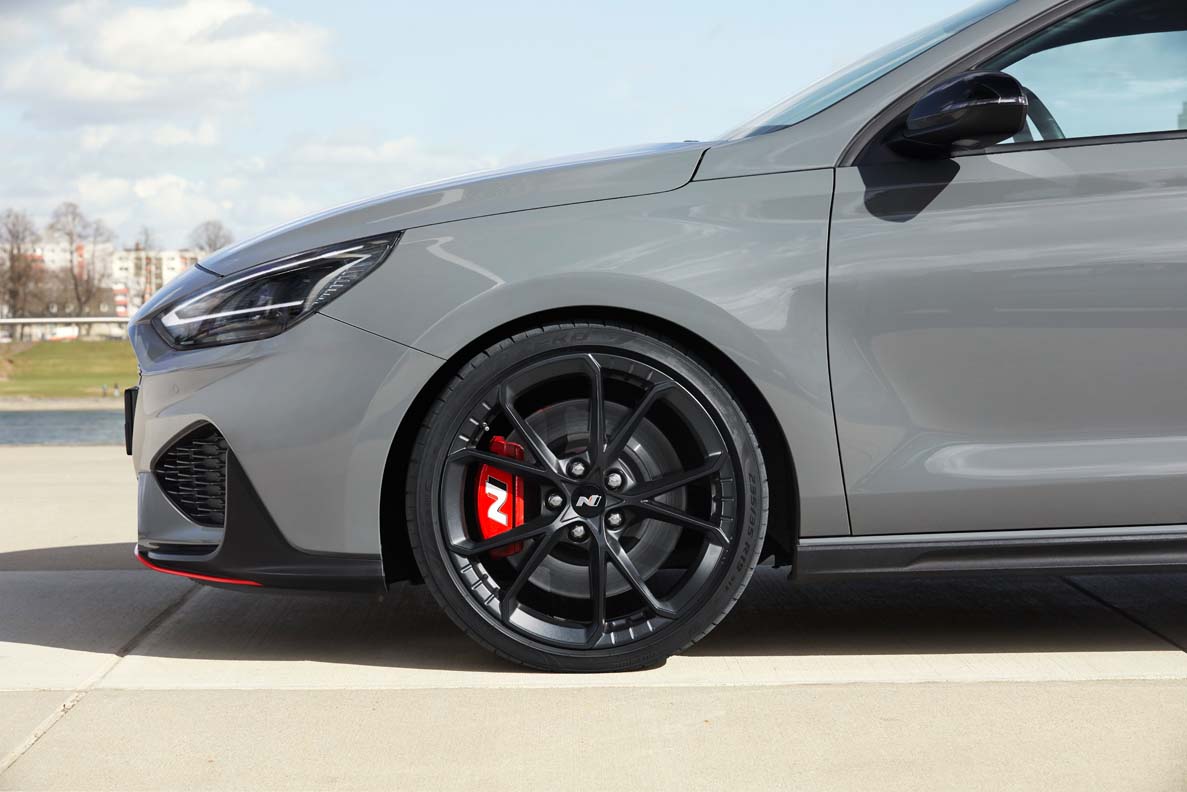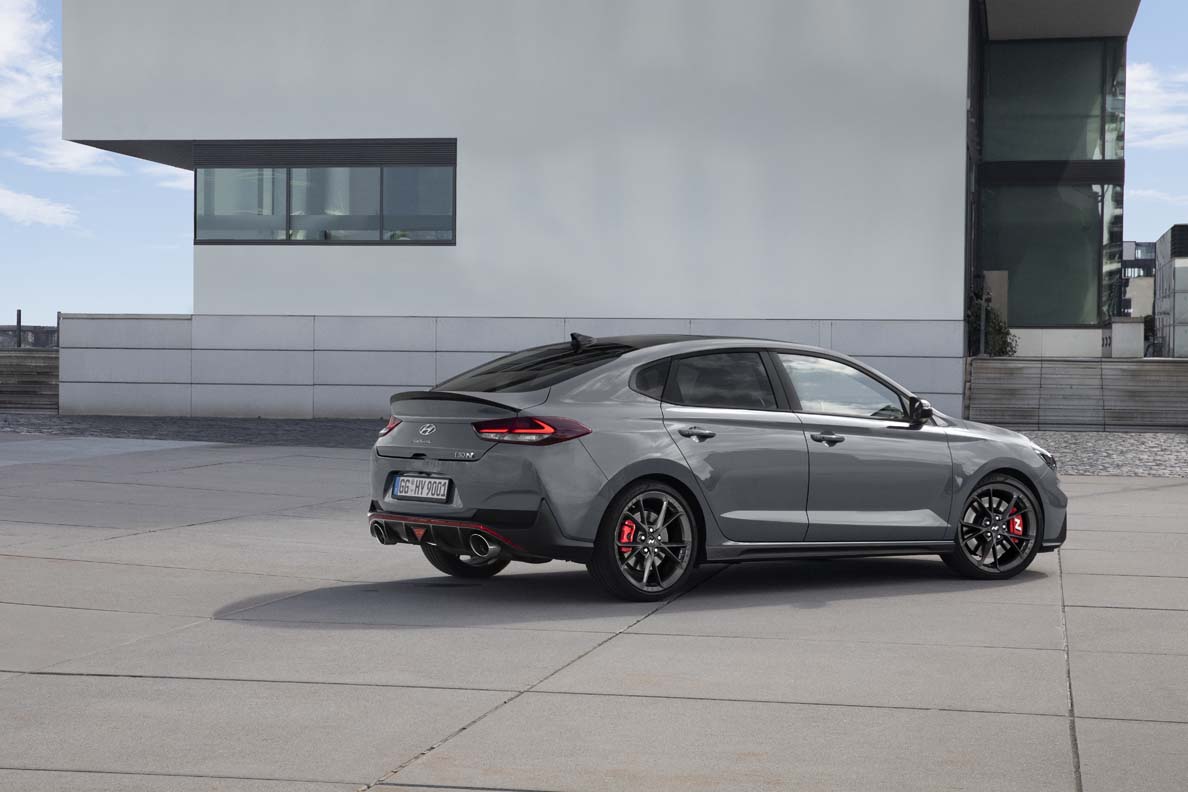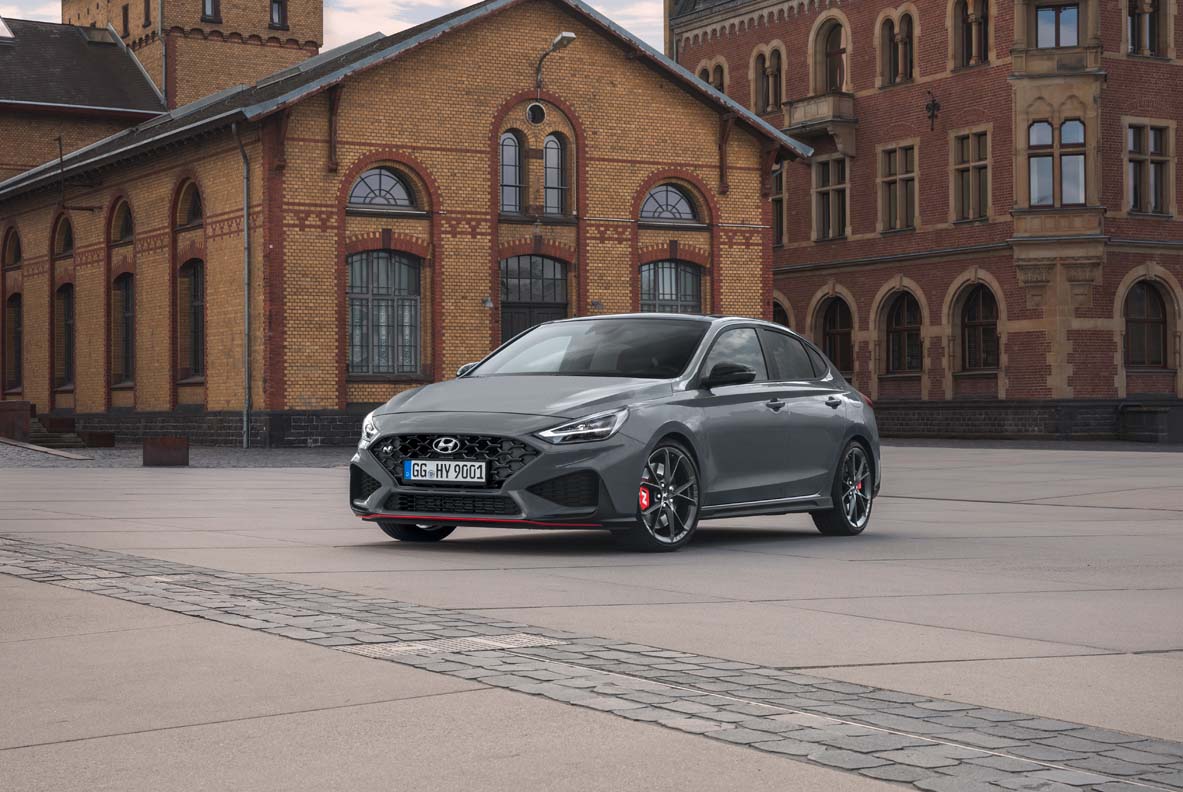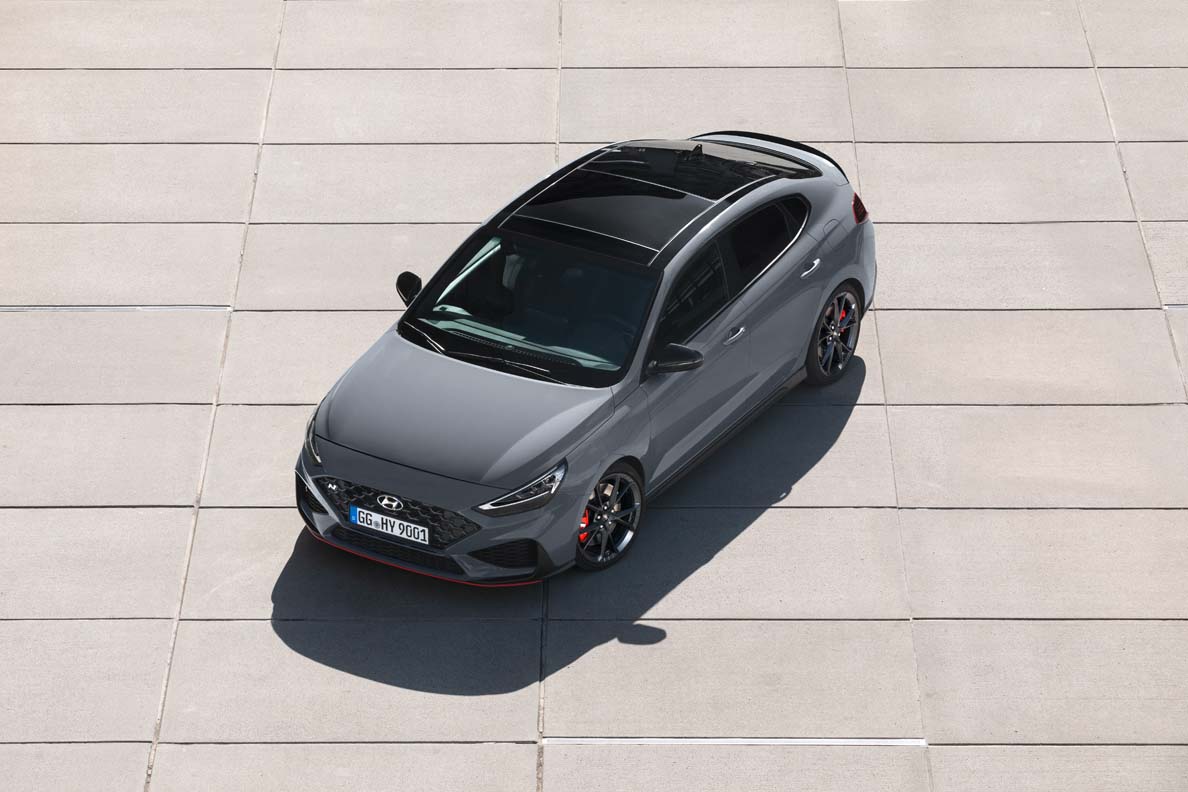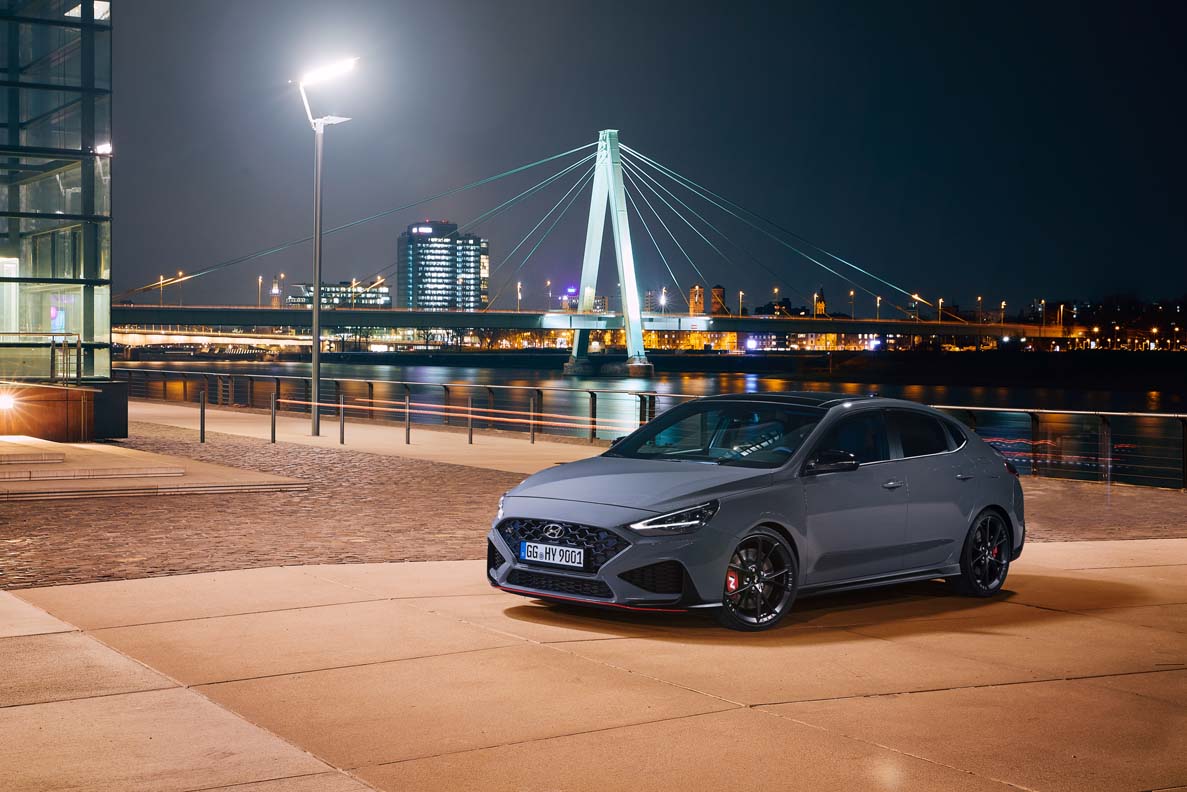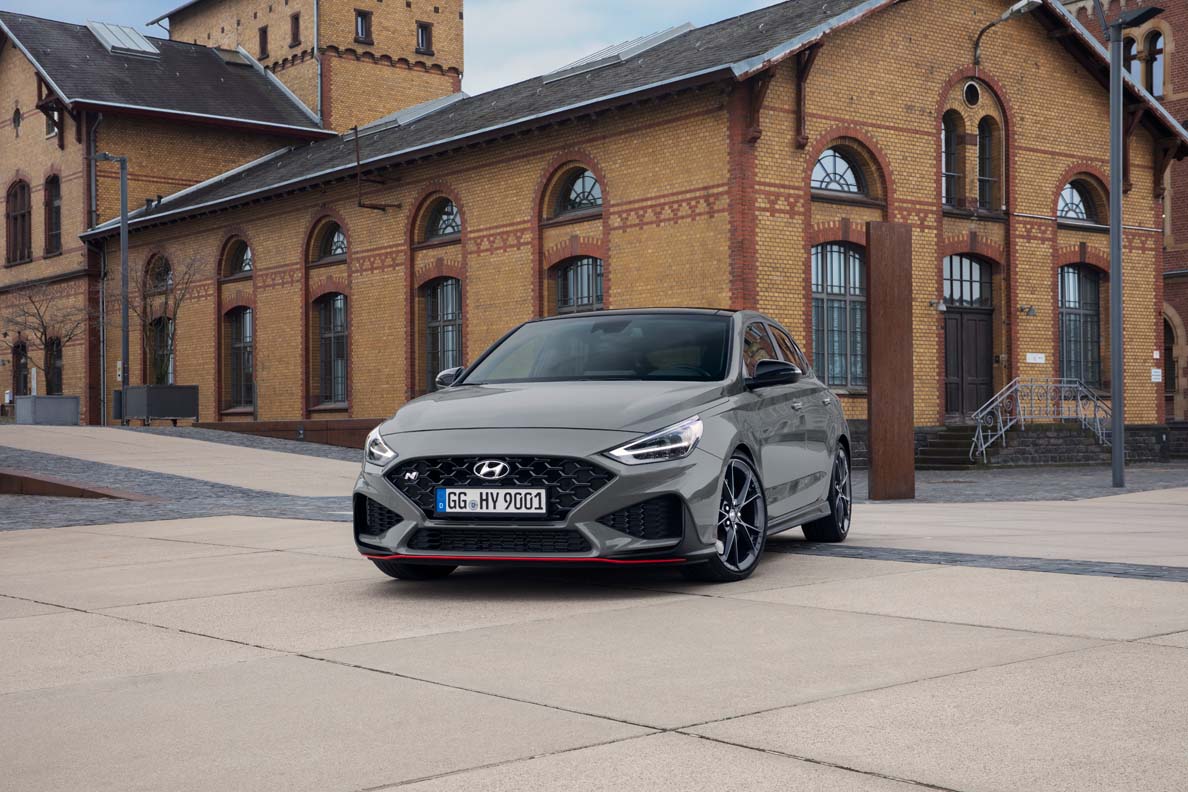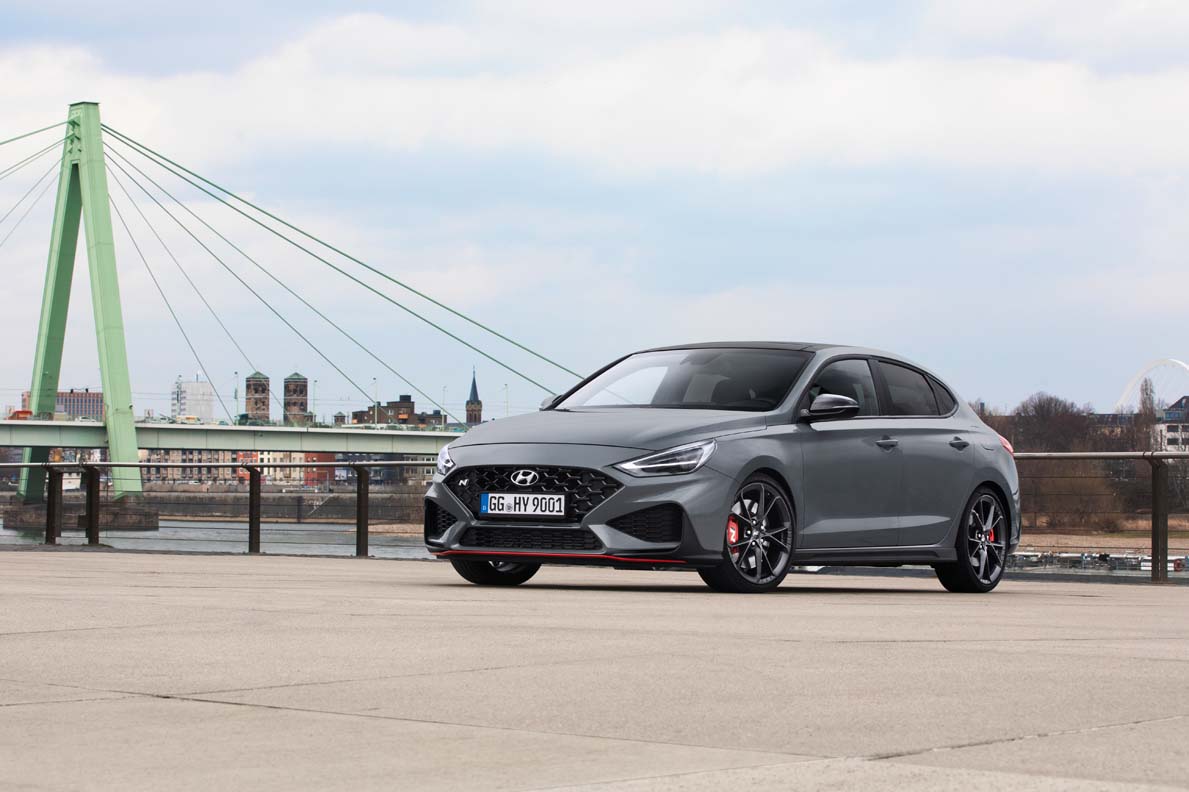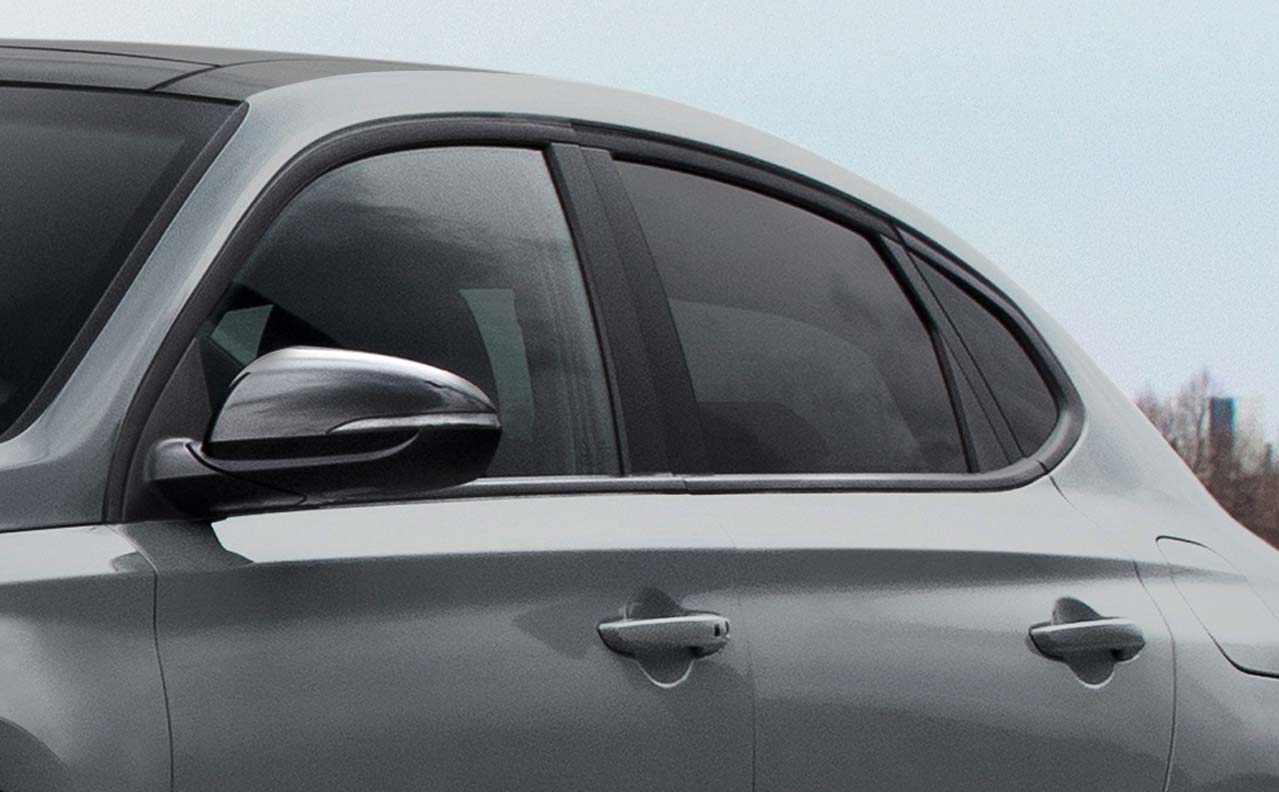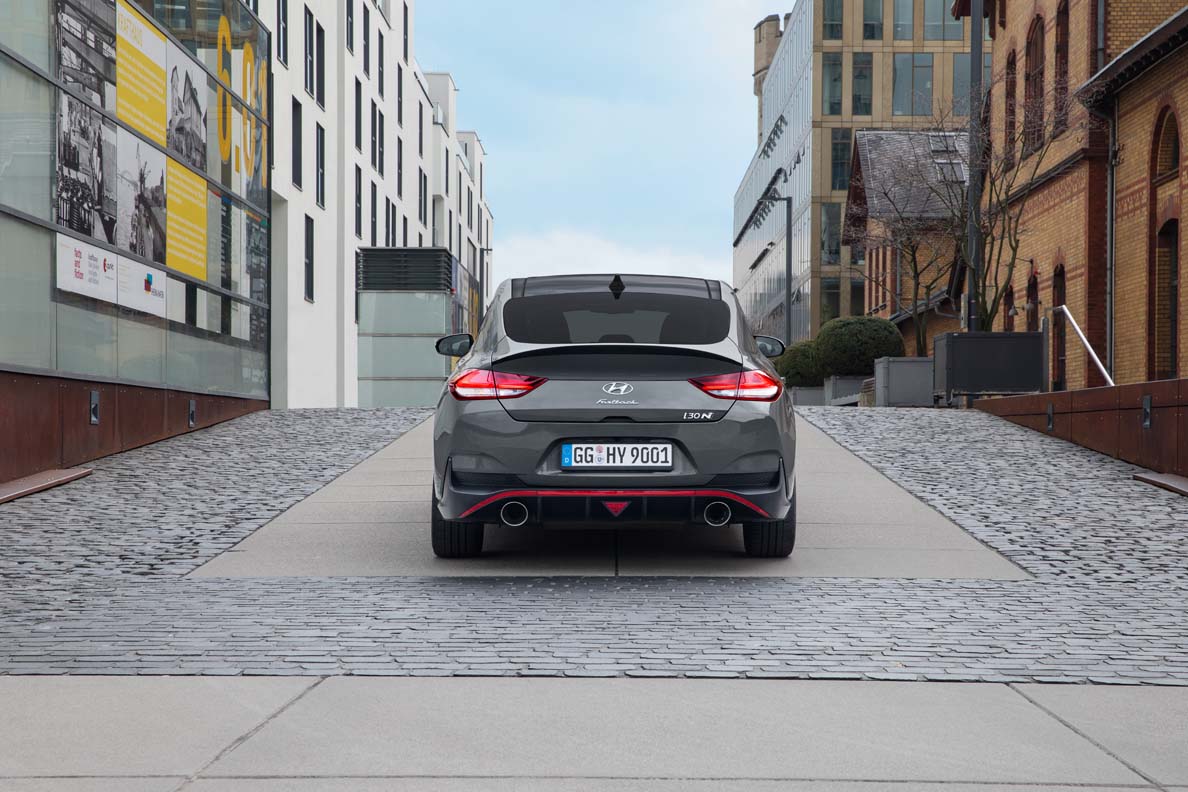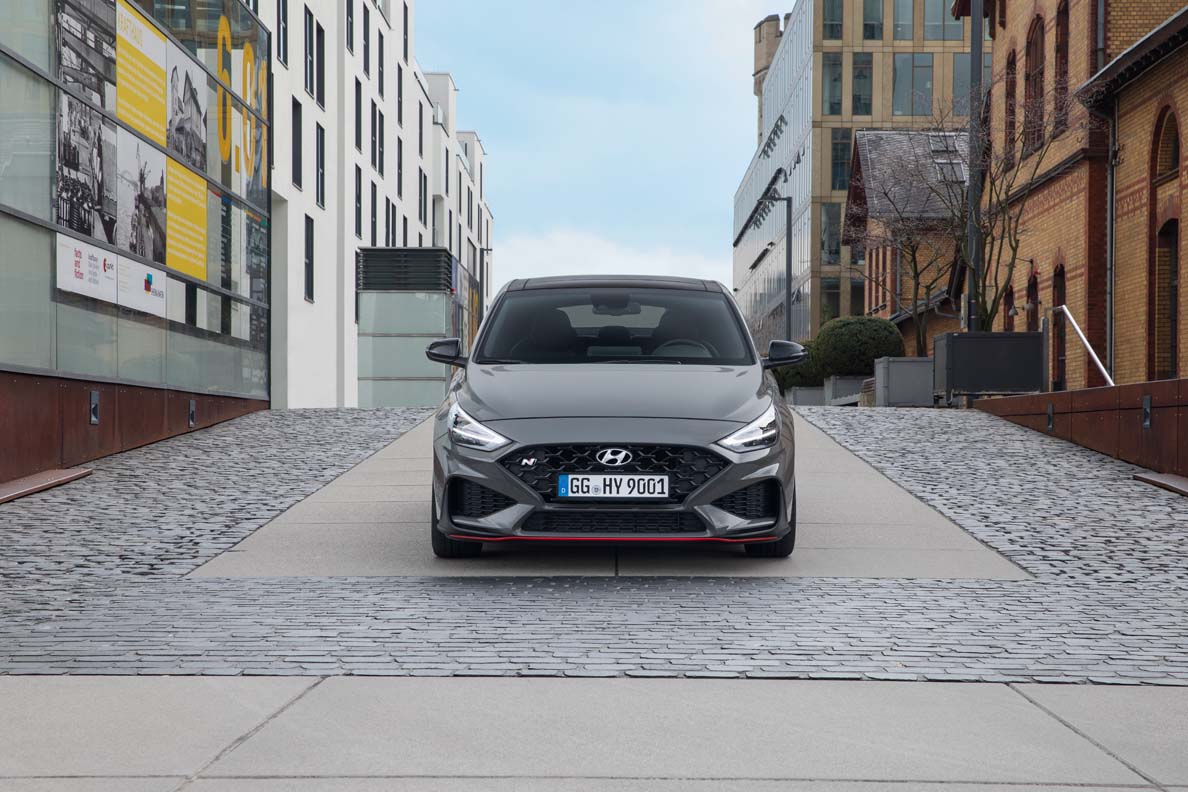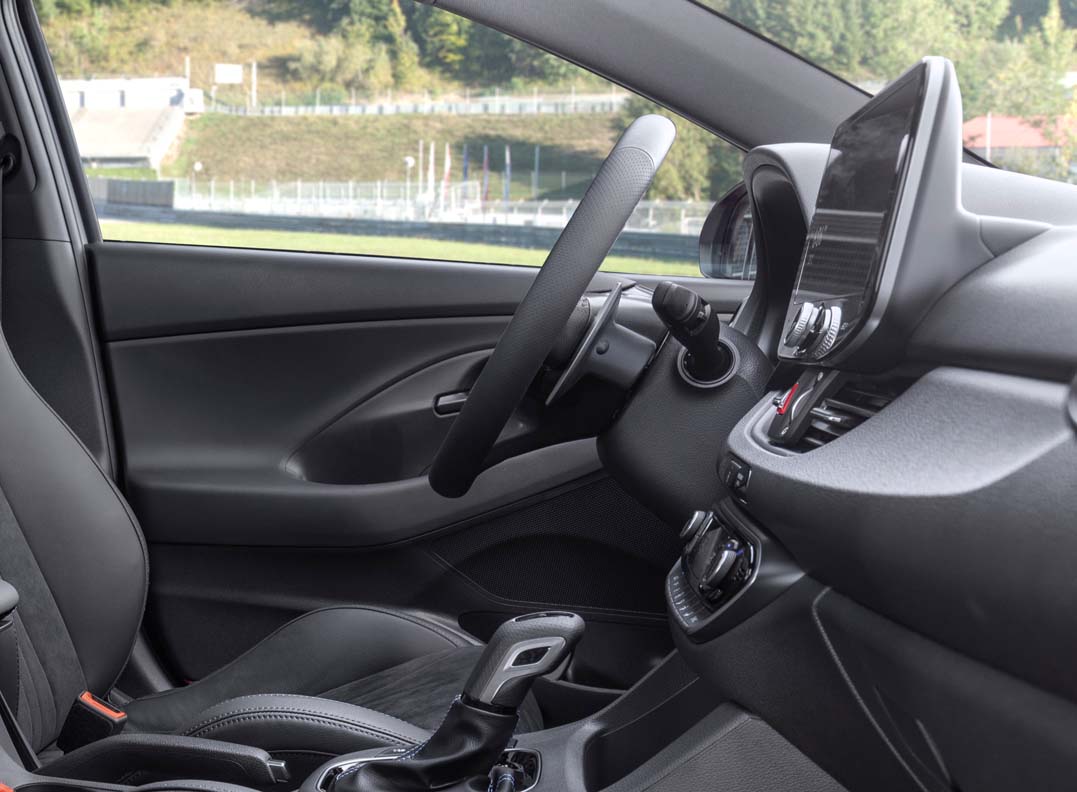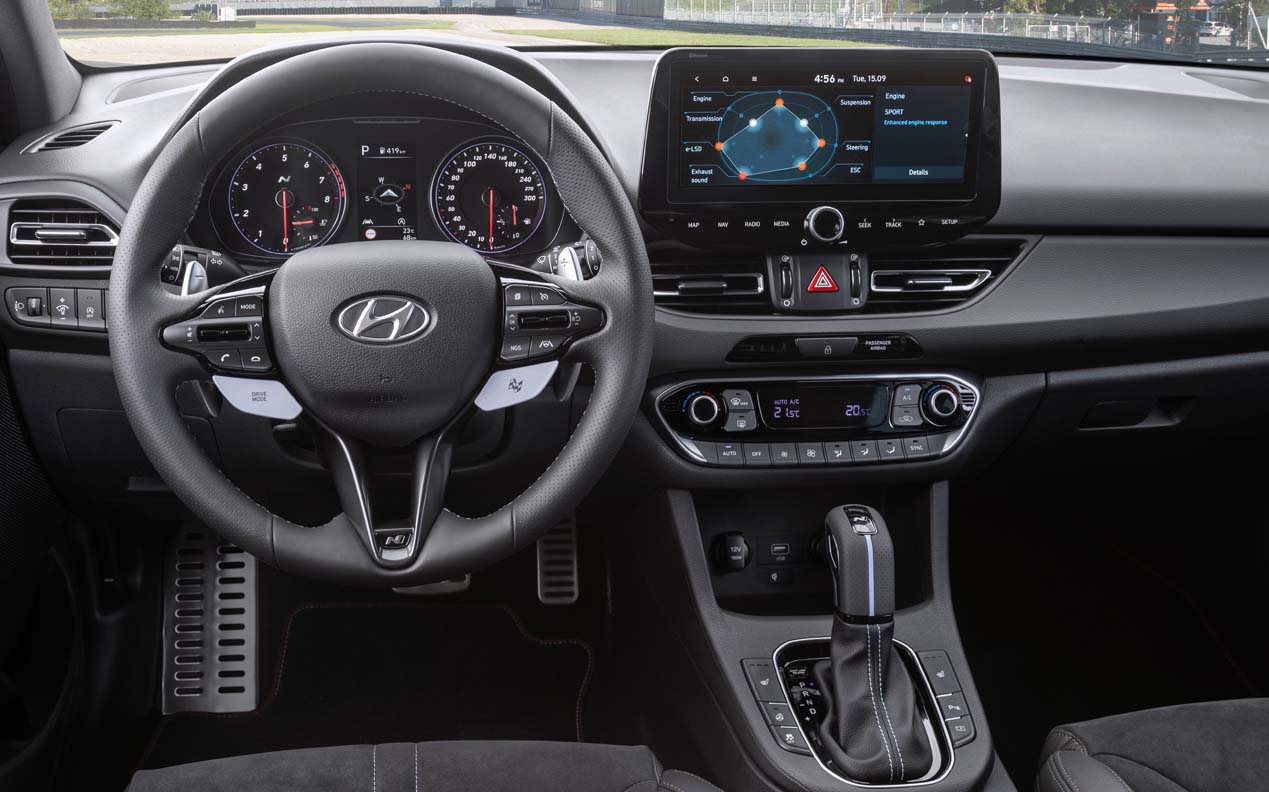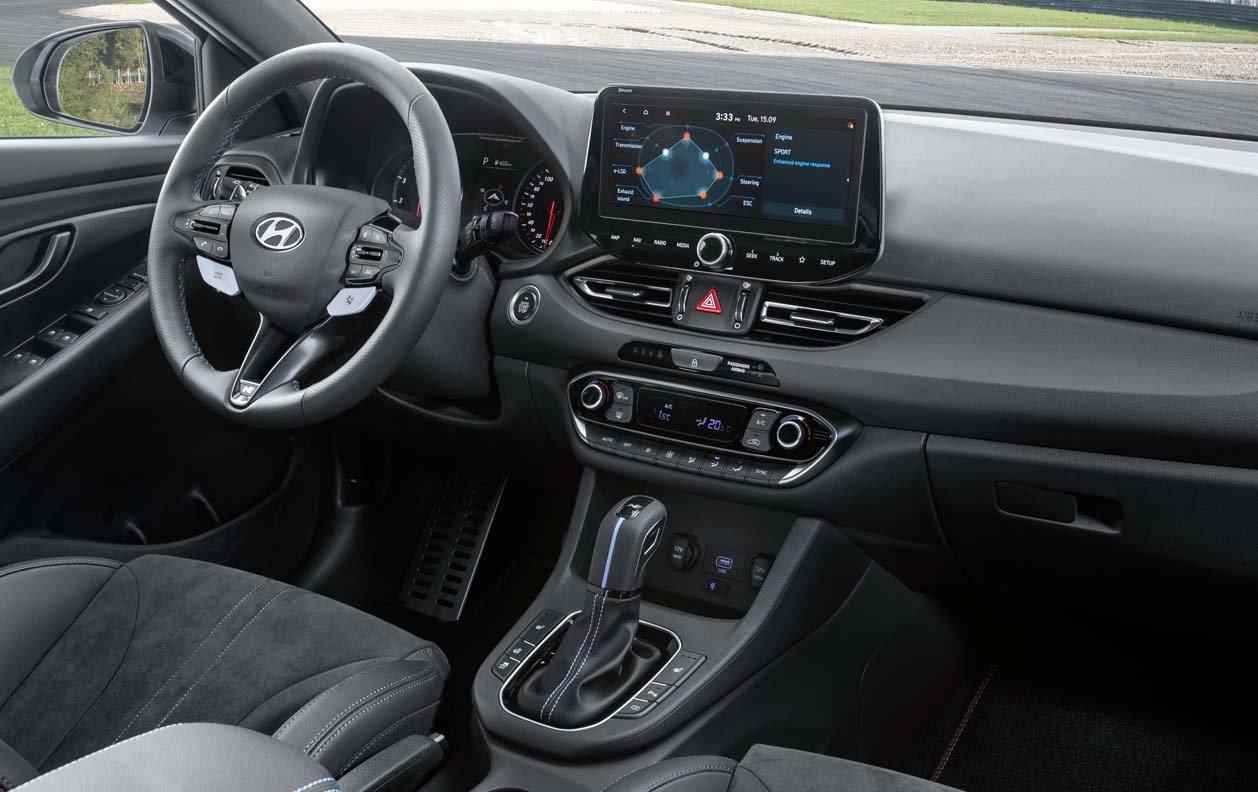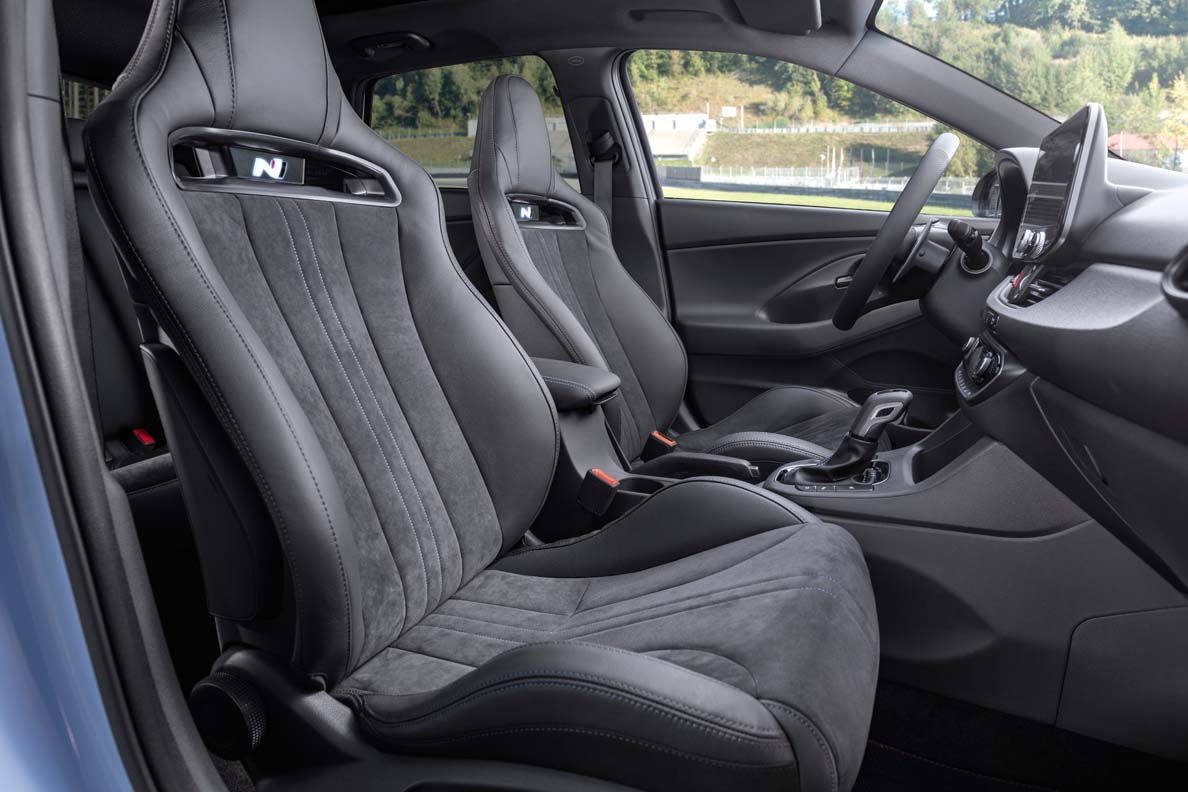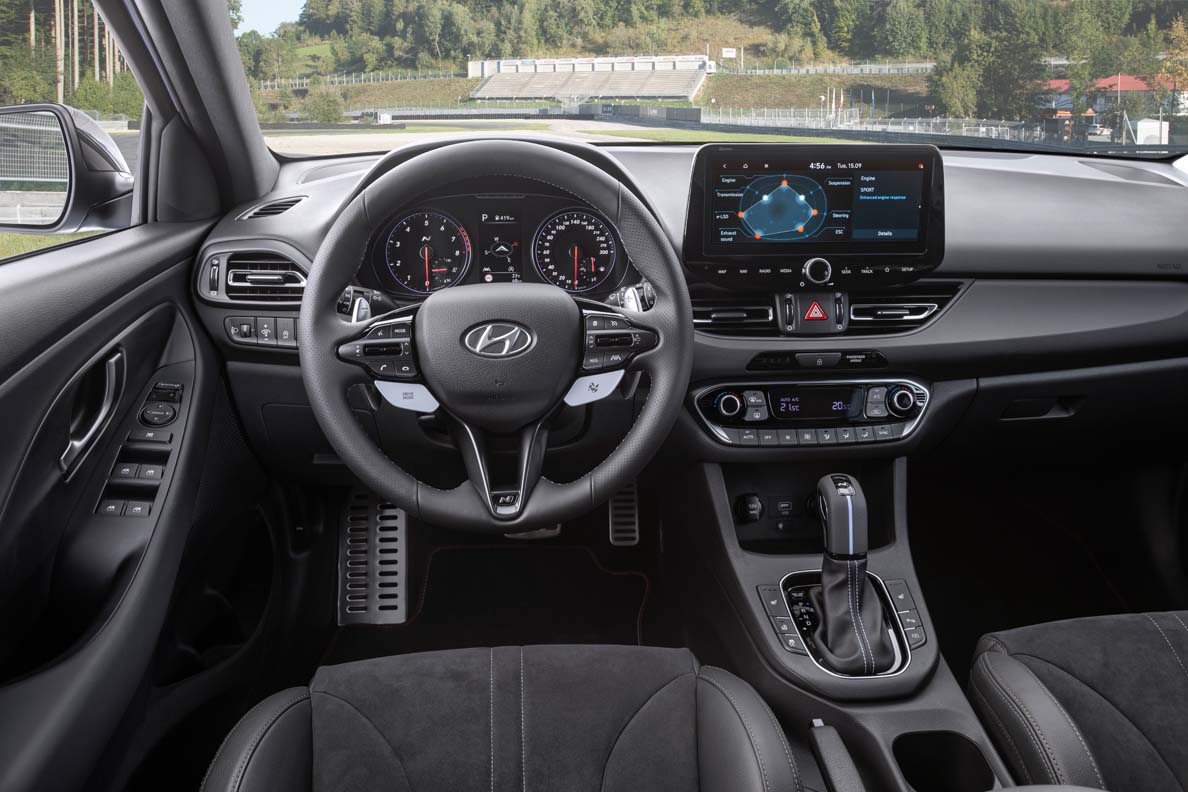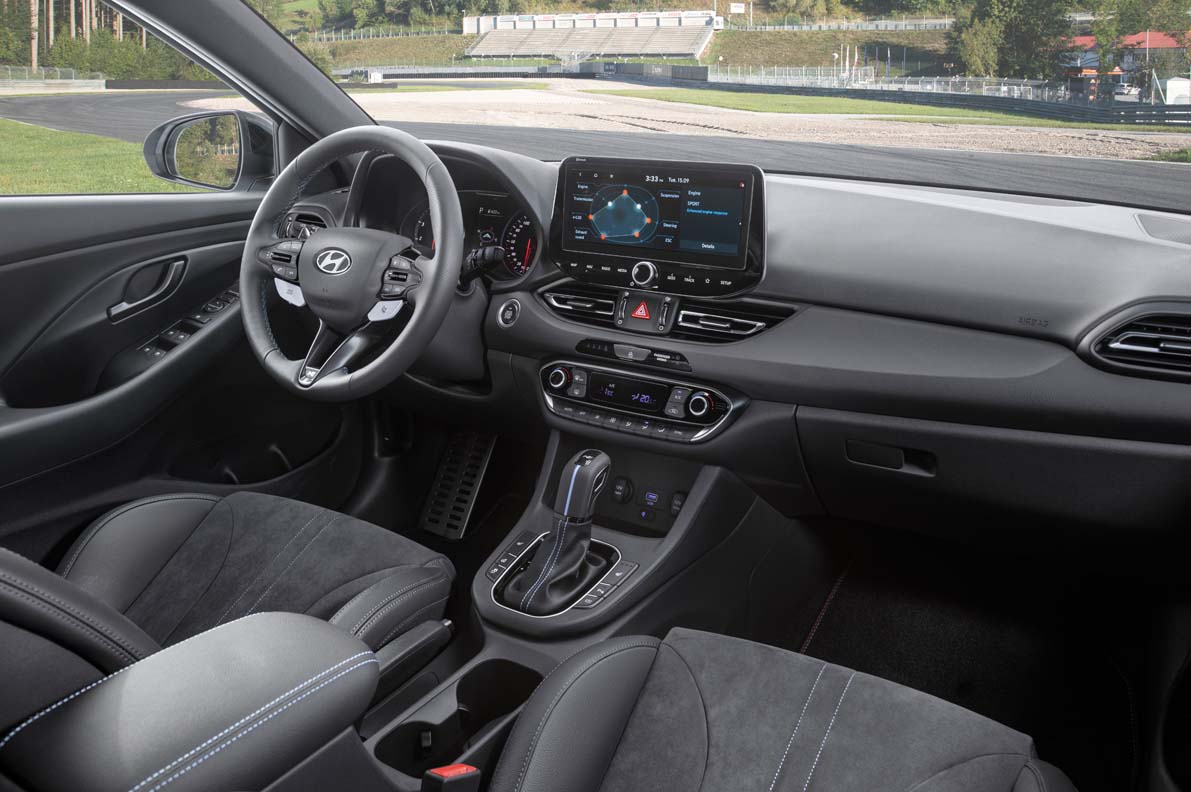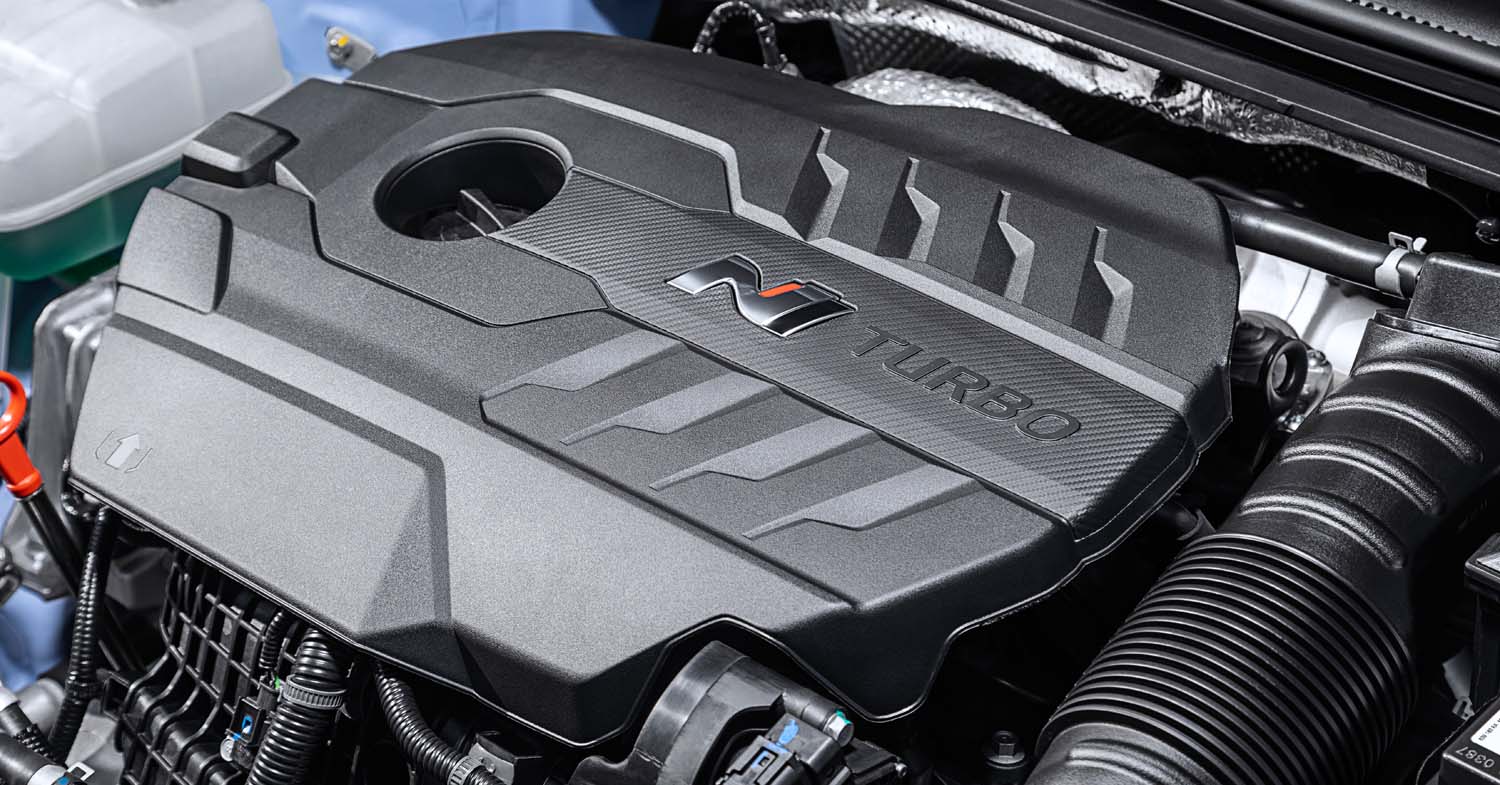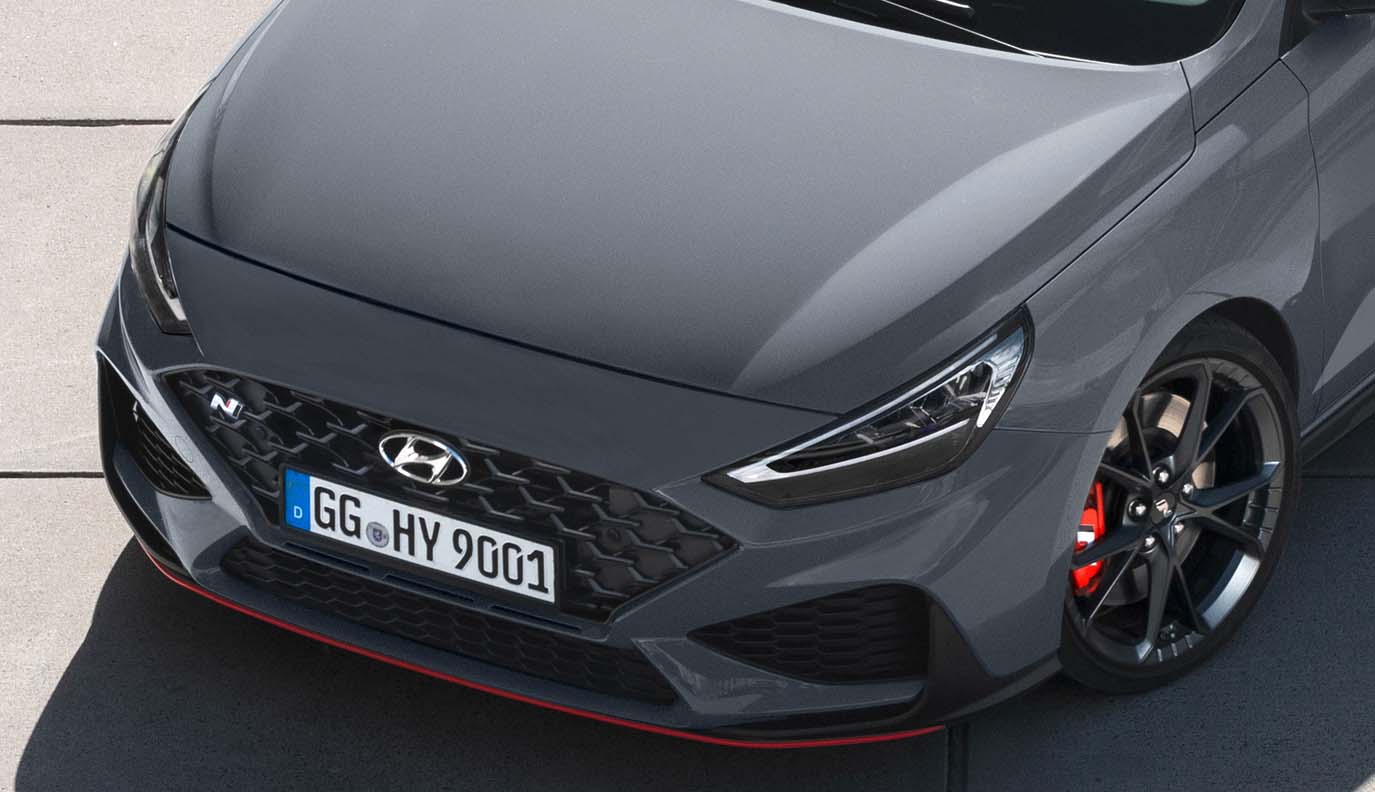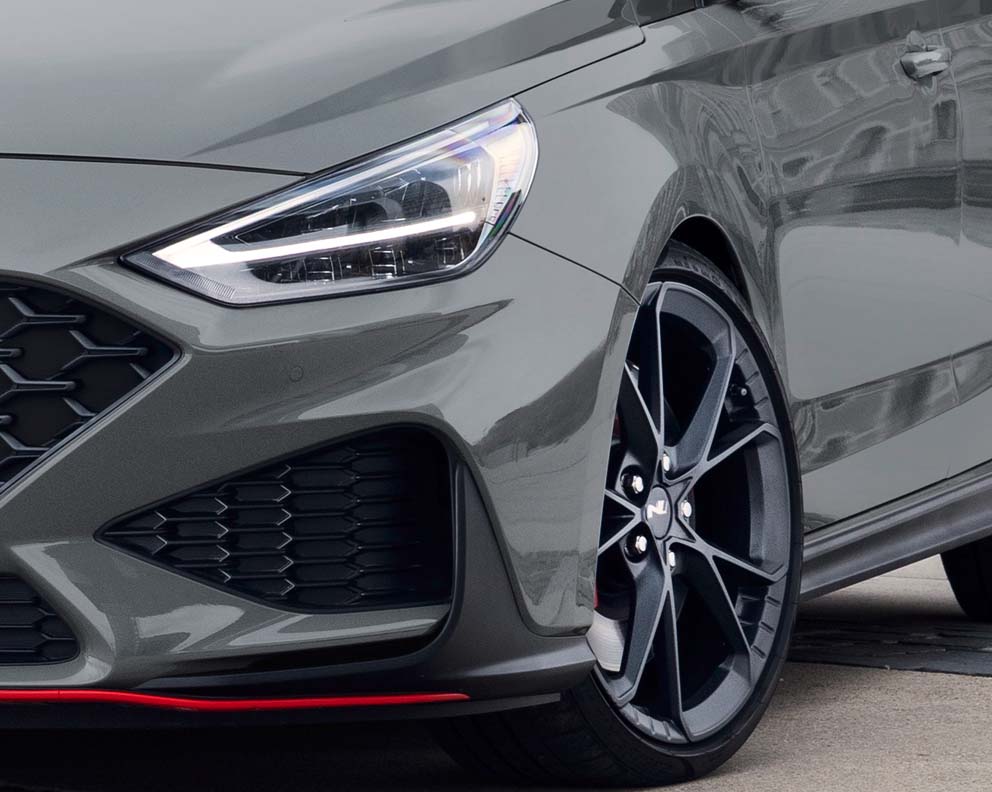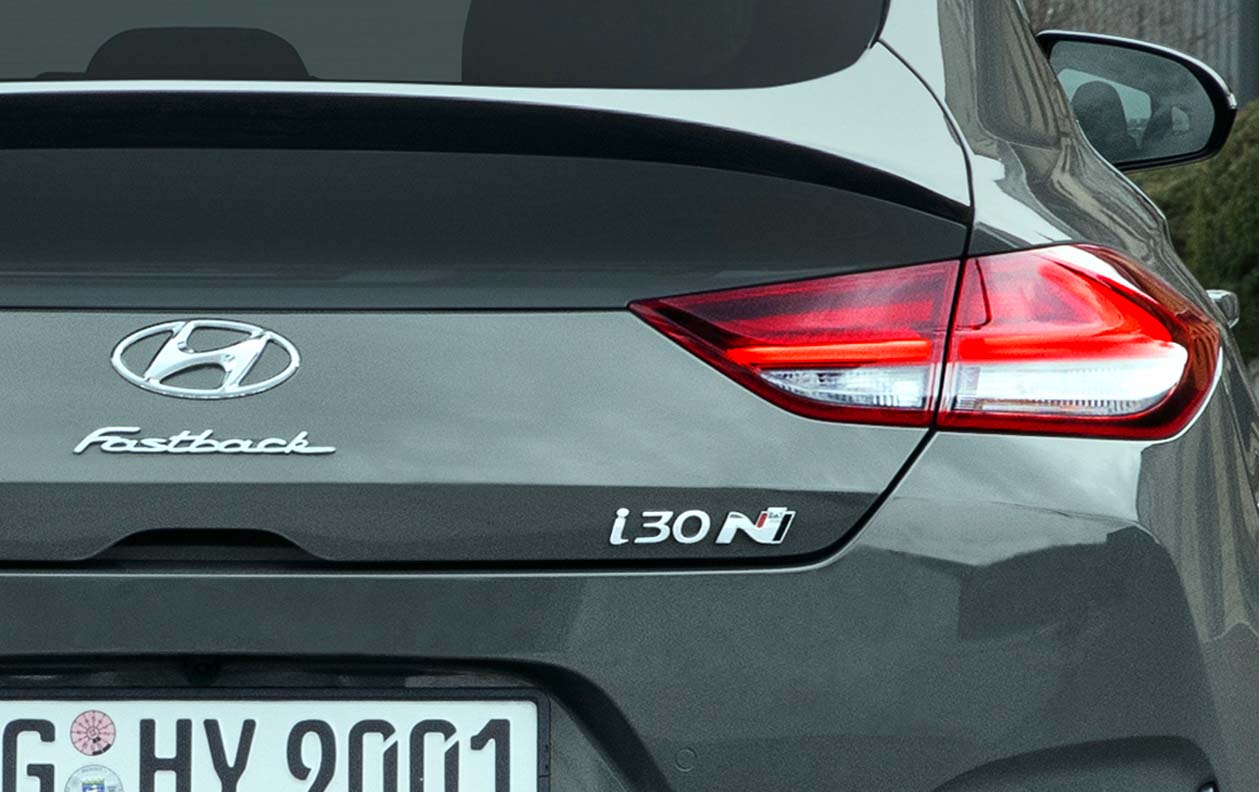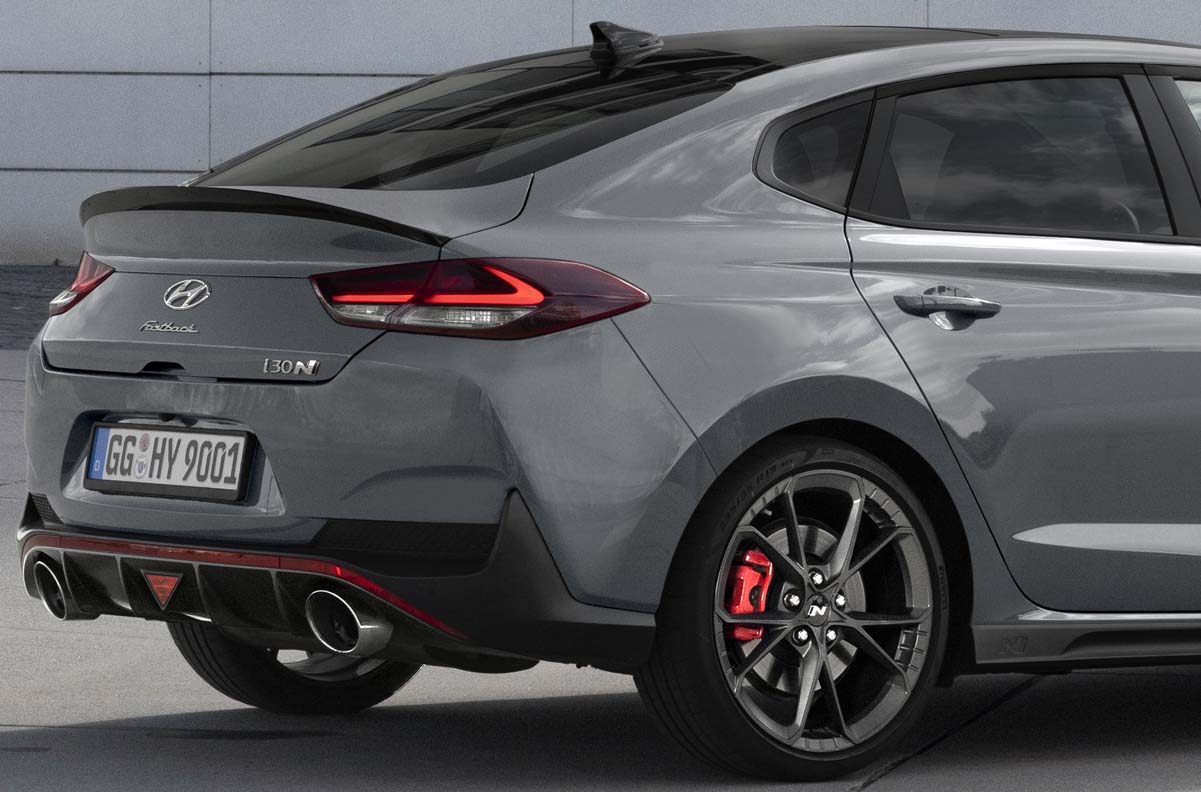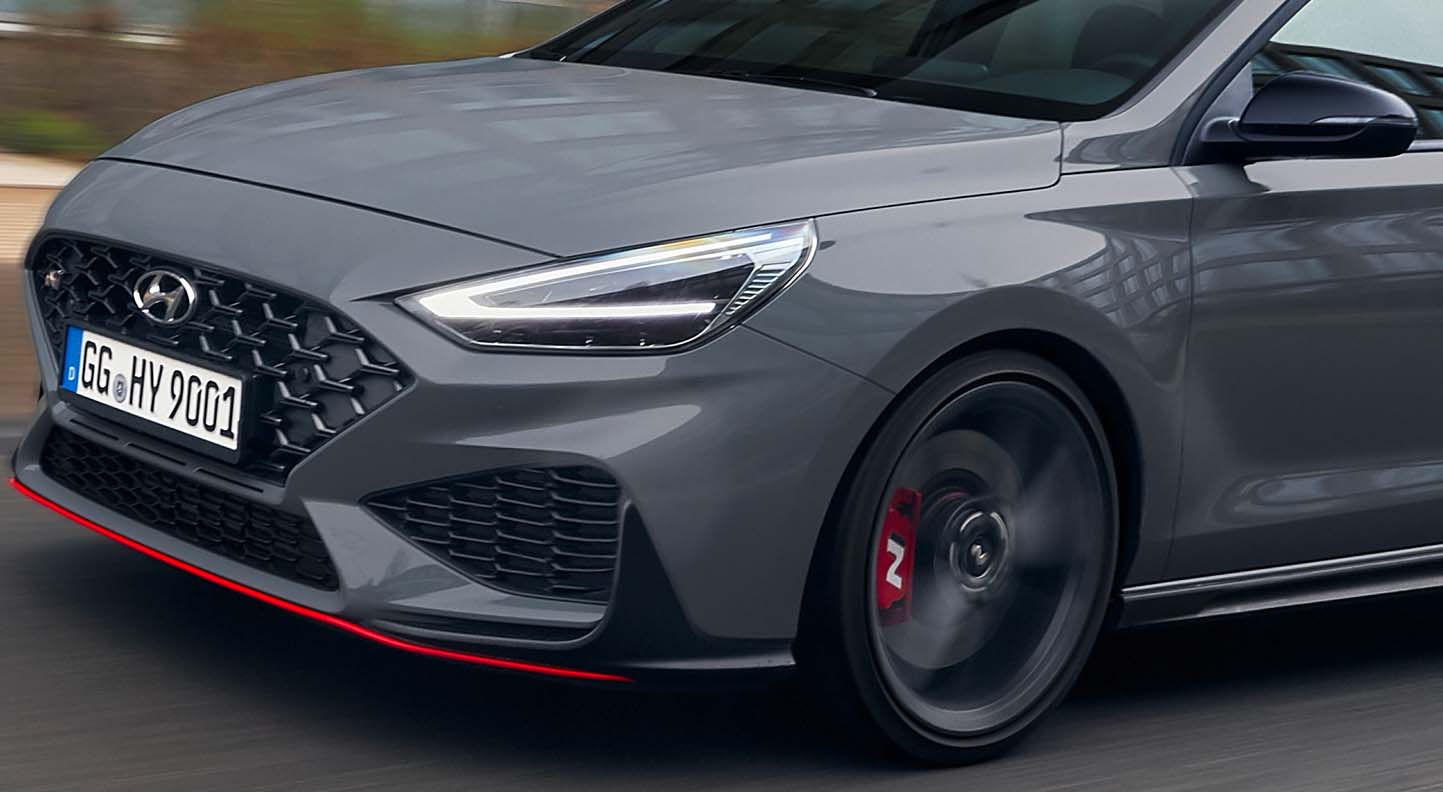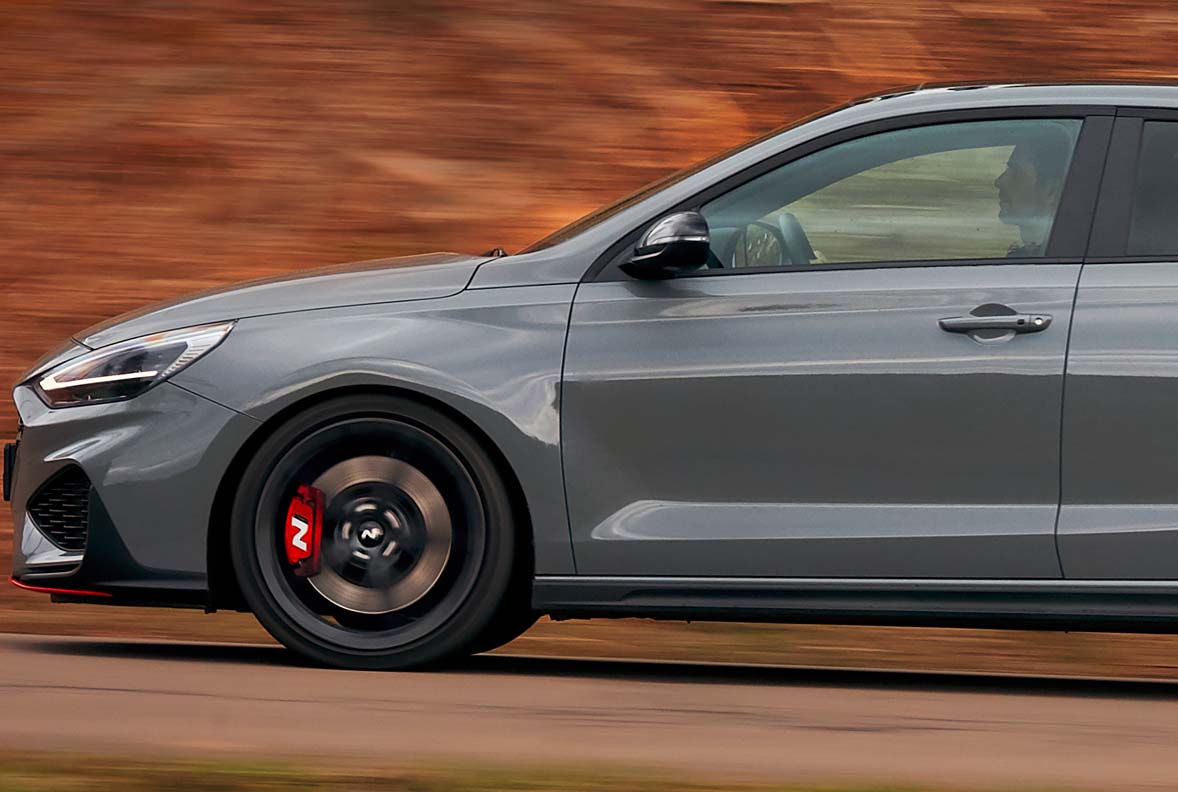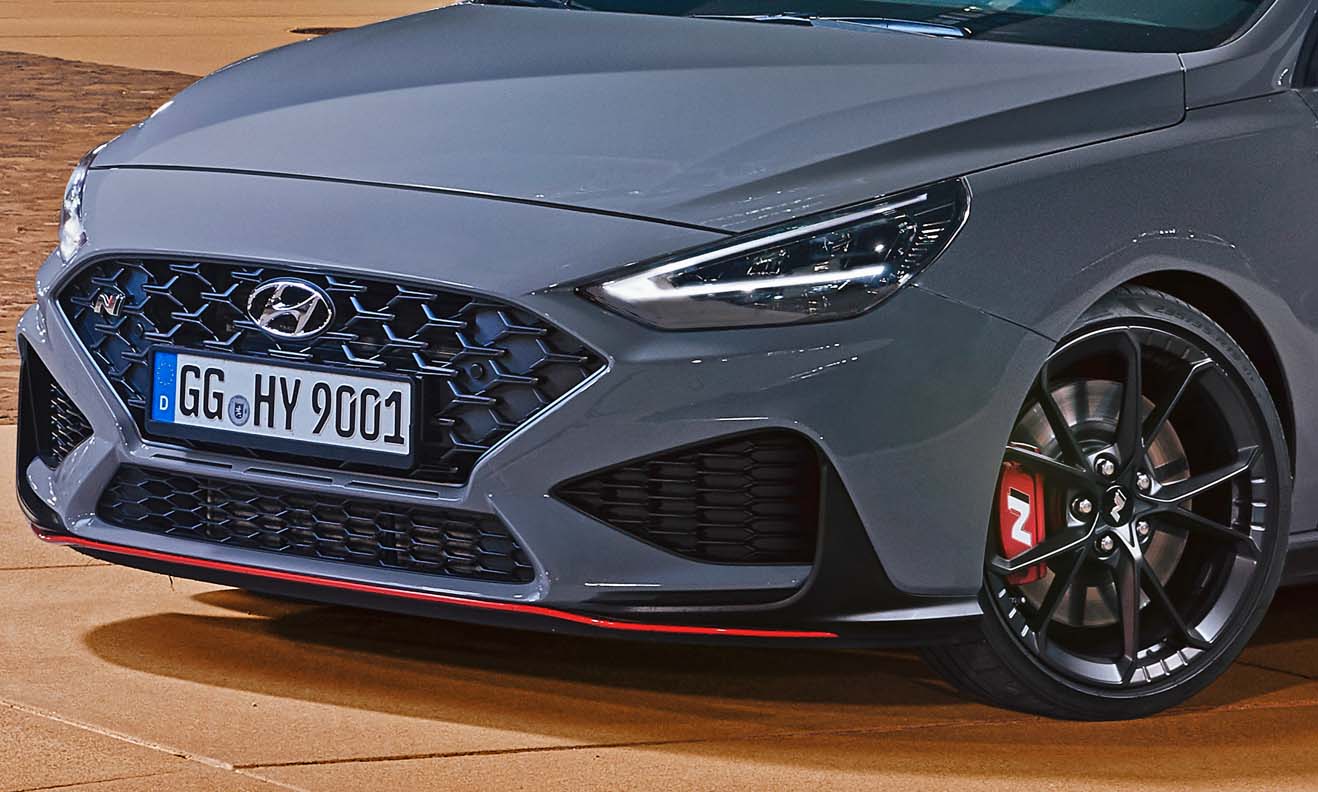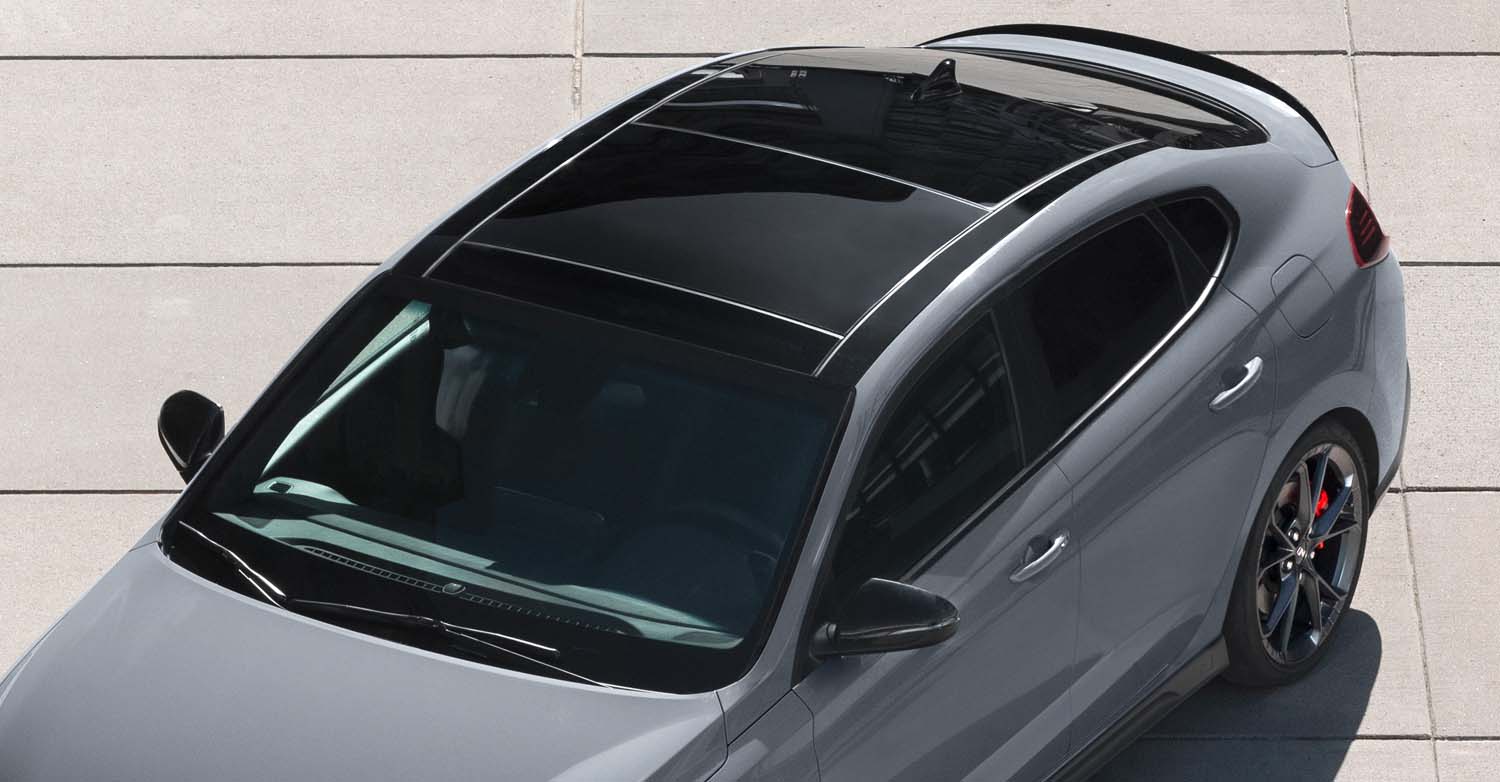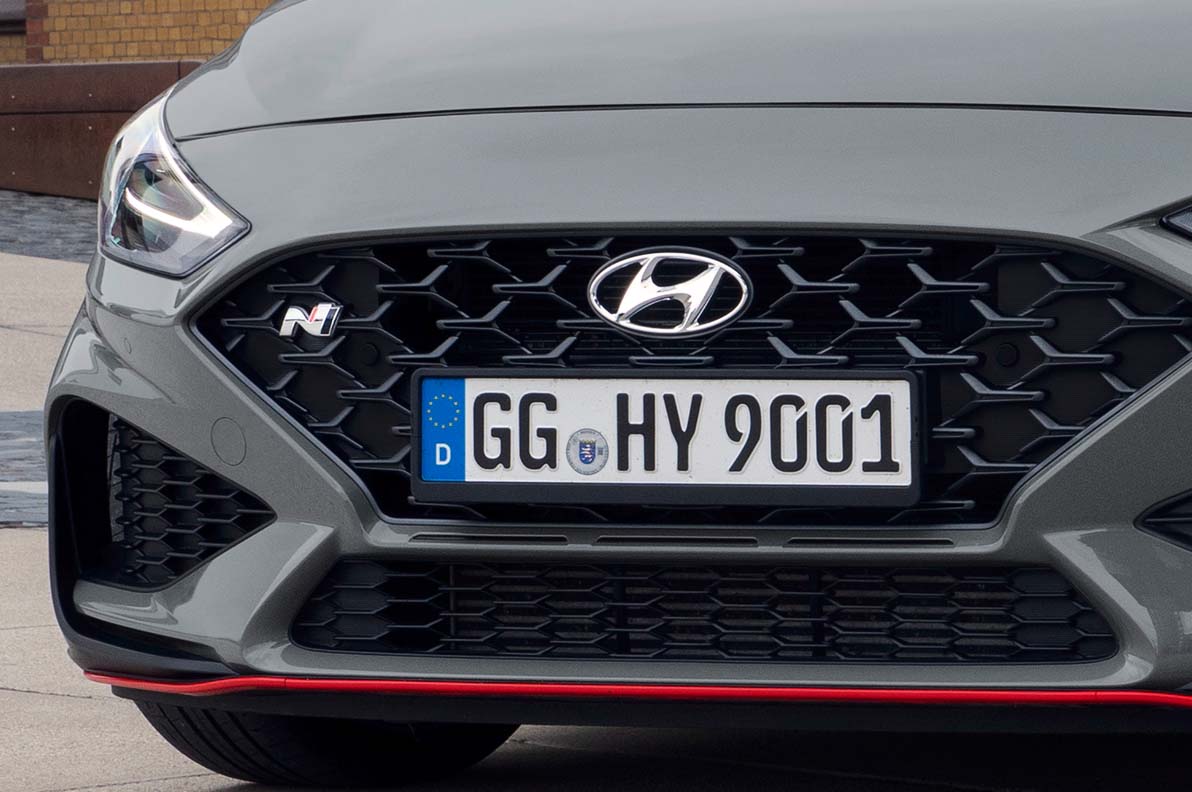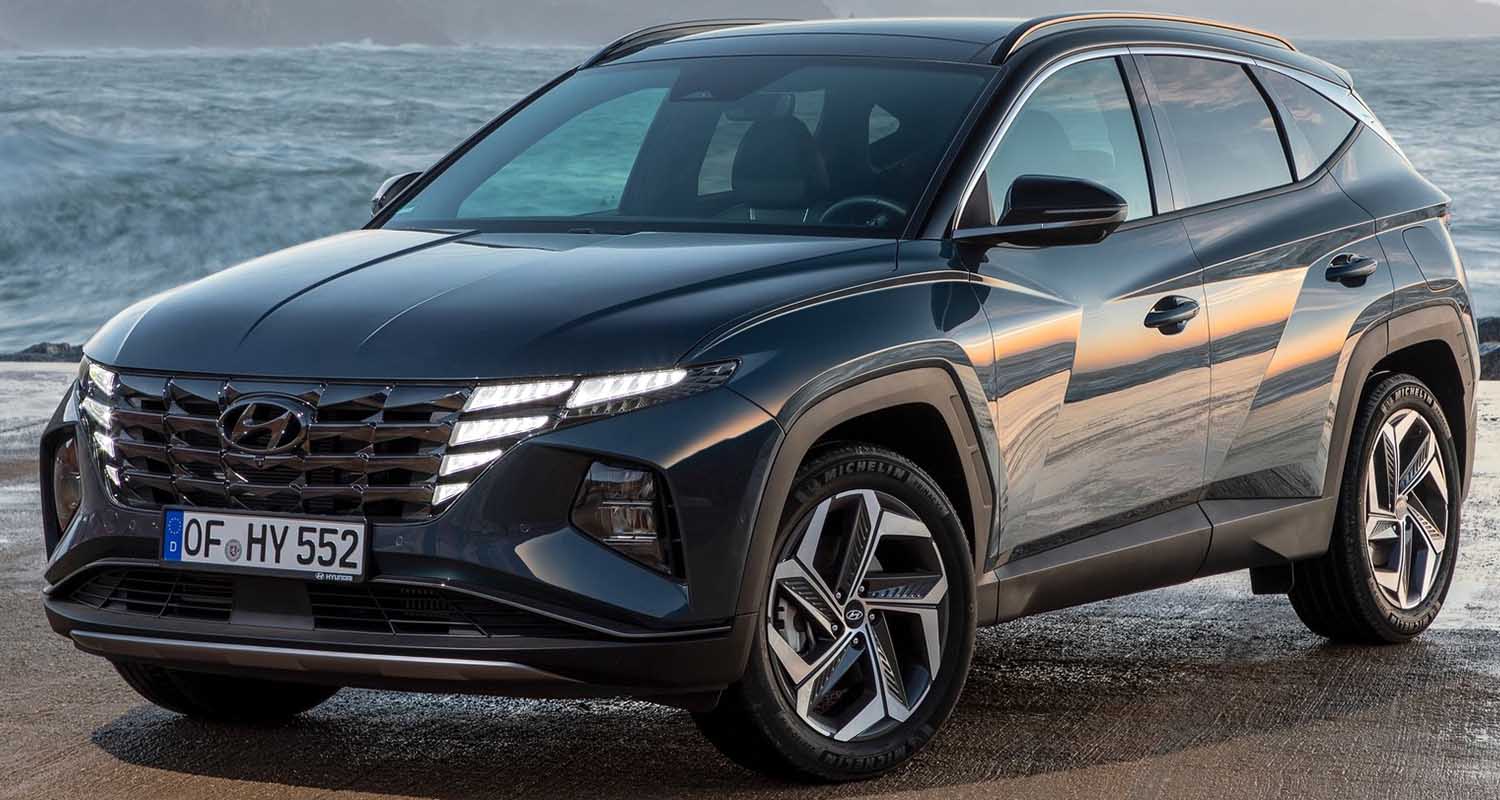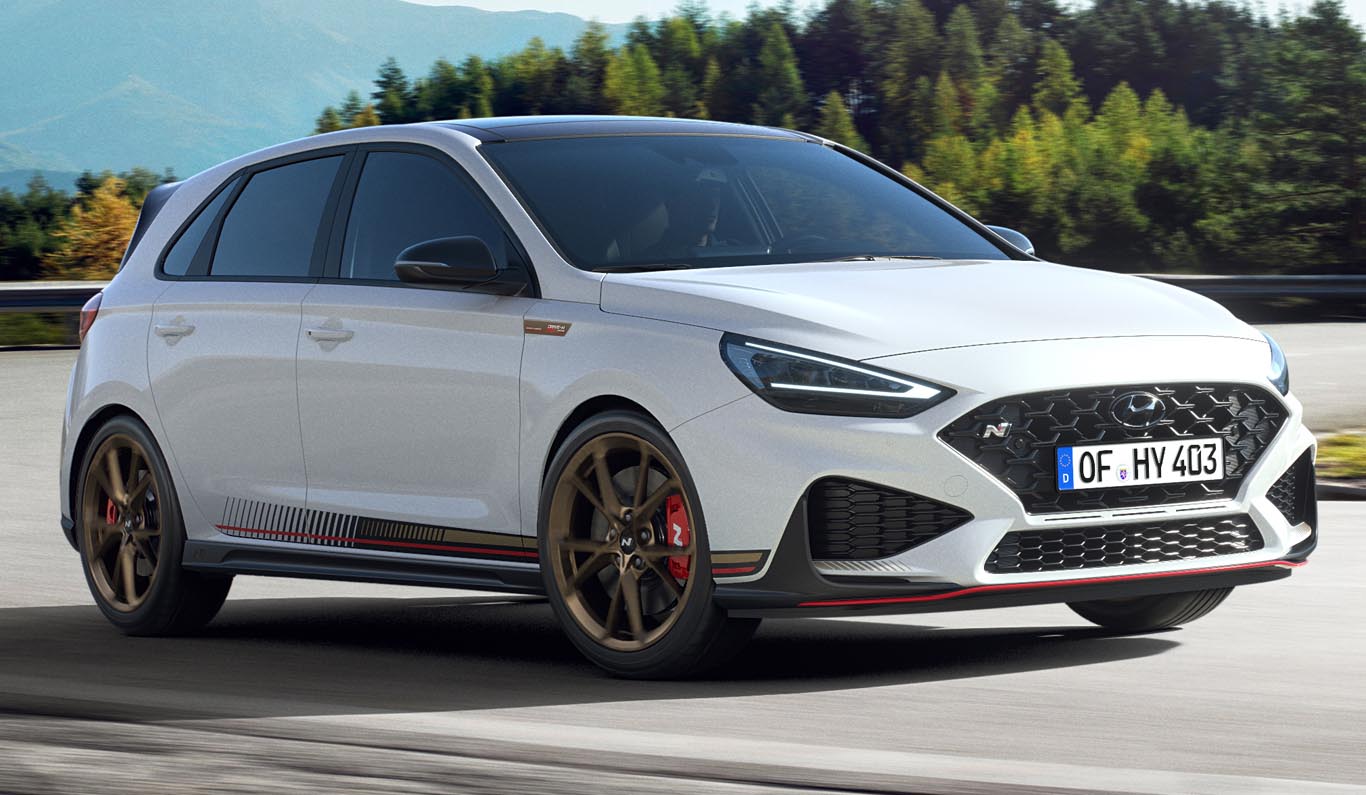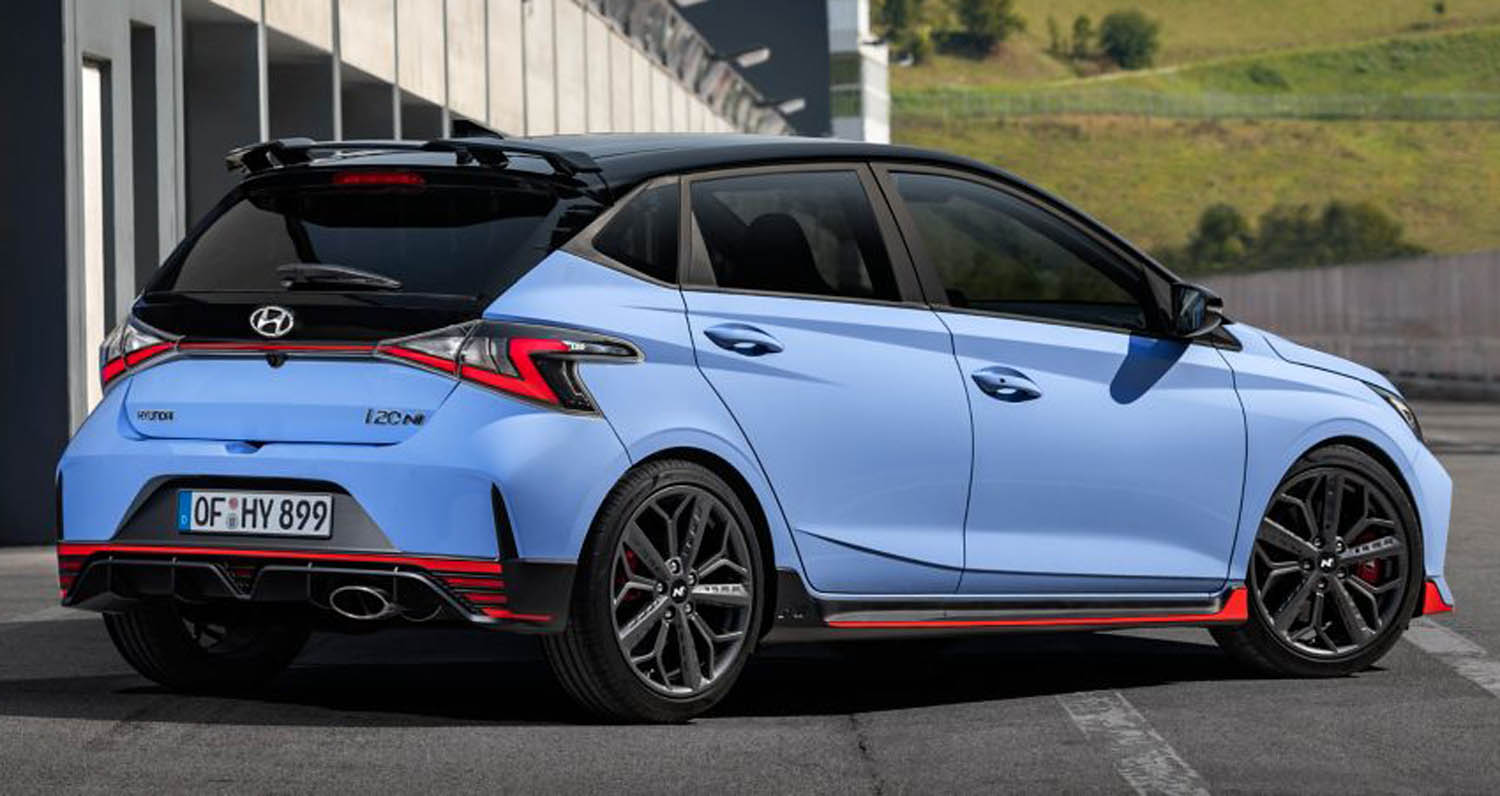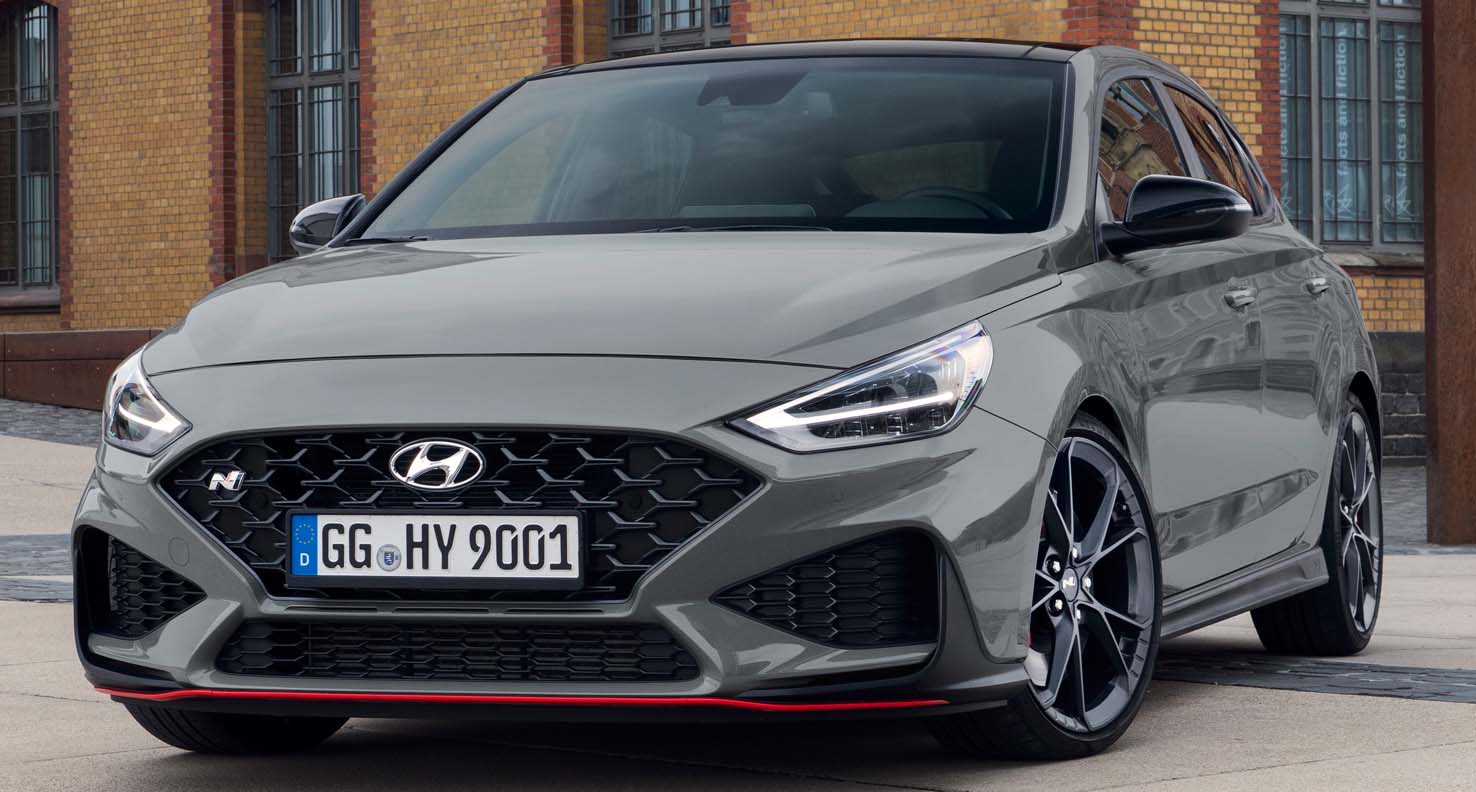
The Hyundai i30 N originally launched in 2017, selling over 28,000 units in Europe alone and winning a number of awards, including the Auto Bild Sports Car of the Year 2018 and 2020. In 2020, i30 N was “Import Winner” in the “Small and Compact Car” category in the 2020 Auto Bild Sports Cars Award. Hyundai N models have inspired a community of fans known as “N-thusiasts”.
The new i30 N builds on the successes of its predecessor, offering a range of design and driving enhancements. It is equipped with more lightweight materials, resulting in more agility and better handling. Like its antecedent model, the new i30 N is available in both hatchback and fastback body types.
The new Hyundai i30 N has been enhanced with a new design focused on performance, emotion and statement. For the first time, the new i30 N will be available with N DCT, an eight-speed dual-clutch transmission, which offers paddle shifters and enables three new N performance functions for an even sportier driving experience. New 19-inch forged alloy wheels and N Light Seats further reduce the weight, resulting in more agile handling. Additional high-performance driving features combined with updated safety and connectivity technology makes the new i30 N a racetrack capable everyday sports car.
Design
The new i30 N’s design can be described in three words: performance, emotion, statement. Beyond a styling exercise, the changes made exclusively for the i30 N define its performance. To create the best ratio between the new i30 N’s downforce, drag and aerodynamics for the best possible driving experience, the designers worked in accordance with aerodynamic principles. Every design feature around the car has been developed with a focus on dynamic performance: the new i30 N’s appearance shows that it was naturally born for the racetrack.
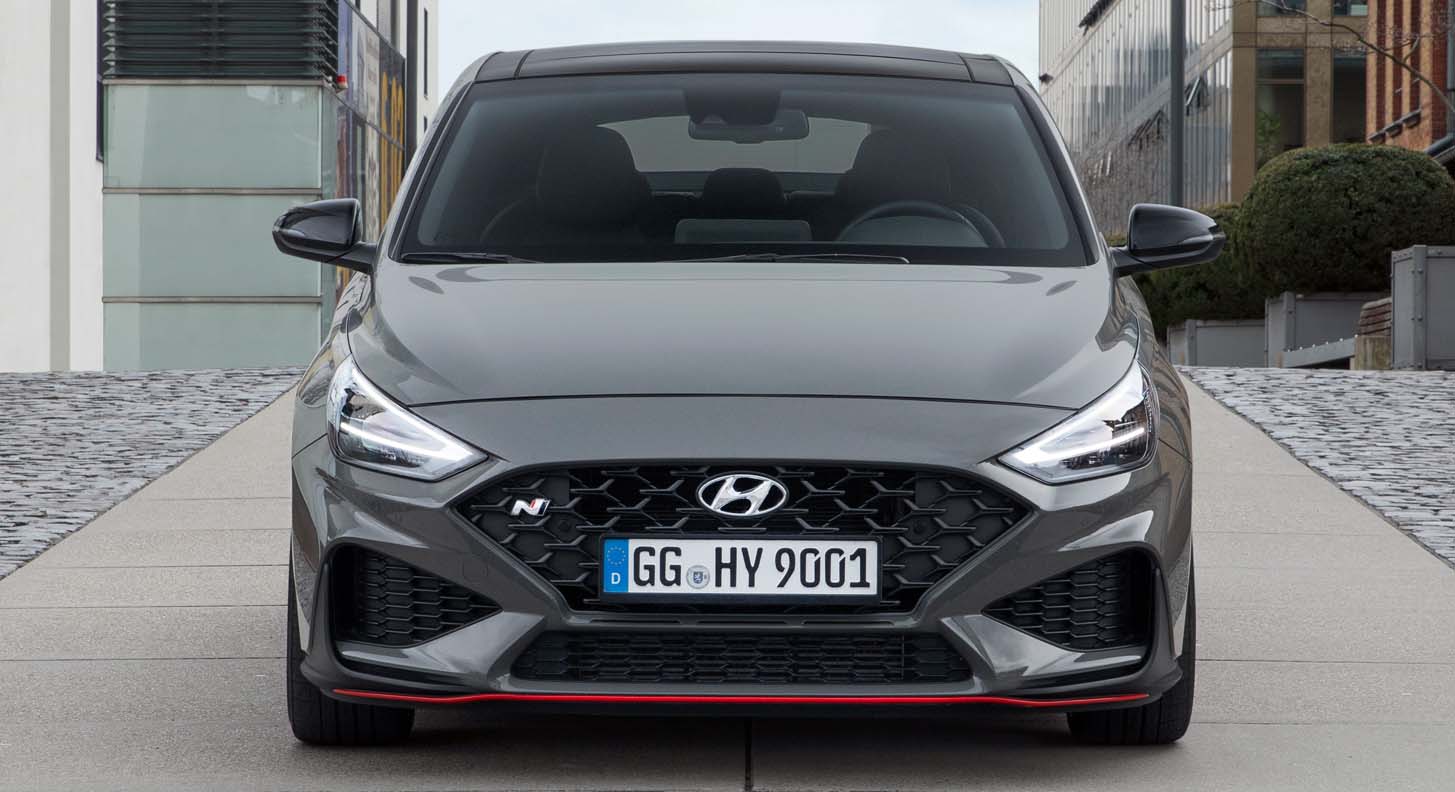
Exterior Design
At the front, the i30 N also maintains its sporty, aggressive appearance through the black bezel of the headlamps. New to this model are enhanced LED headlamps with V-shaped Daytime Running Lights (DRLs) and V-shaped LED combi lamps at the rear. The N signature can be found on the wide centre grille. Its specific, sharp mesh design reminds the viewer of airplane wings and has been optimised to allow efficient engine cooling. It is fitted with 18-inch alloy wheels and Michelin Pilot Super Sport Tyres. The N logo has also been integrated onto the wheel caps.
As the front bumper features the prominent cascading grille, particularly stressed through the red insert, the emotional appearance and strong character of the car are once again highlighted. Fresh air inlets on both sides of the car’s front bumper enhance the brake cooling and aerodynamics. Behind the unique cascading grille, additional air curtains offer further performance by enhancing air flow, reducing turbulence in the wheel housing and cooling the engine more effectively. The front splitter and the rear wing spoiler create downforce and an excellent aero-balance. Meanwhile, the outer bumper corners, dominated by the typical aerodynamic side fins, incorporate the air curtains to significantly improve the airflow.
On the hatchback body type, the triangular third brake light in the glossy black spoiler at the updated rear underline the eye-catching look. It additionally features an updated rear end design with a large wing spoiler with a distinctive N triangular brake light. The spoiler creates downforce and excellent balance, while the rear lamps have also been updated and feature a new LED signature. Two large exhaust pipes integrated into the lower bumper diffuser complete the image of the pure high-performance i30 N.
The new Hyundai i30 Fastback N, on the other hand, comes with a discrete glossy black spoiler, while the triangular rear fog light is integrated into the middle of the rear bumper.
The form following function design of the new i30 N makes the car look fast even in standstill. Purposeful and energetic, it is ready to tackle the road and the racetrack.
The new Hyundai i30 N comes in seven exterior colours, including Performance Blue, which is exclusive to Hyundai N models. Because of Hyundai Motor’s motorsport heritage, the unique Performance Blue colouring reflecting the wide open sky was introduced with the start of its WRC engagement in 2014 and has represented the N line-up ever since.
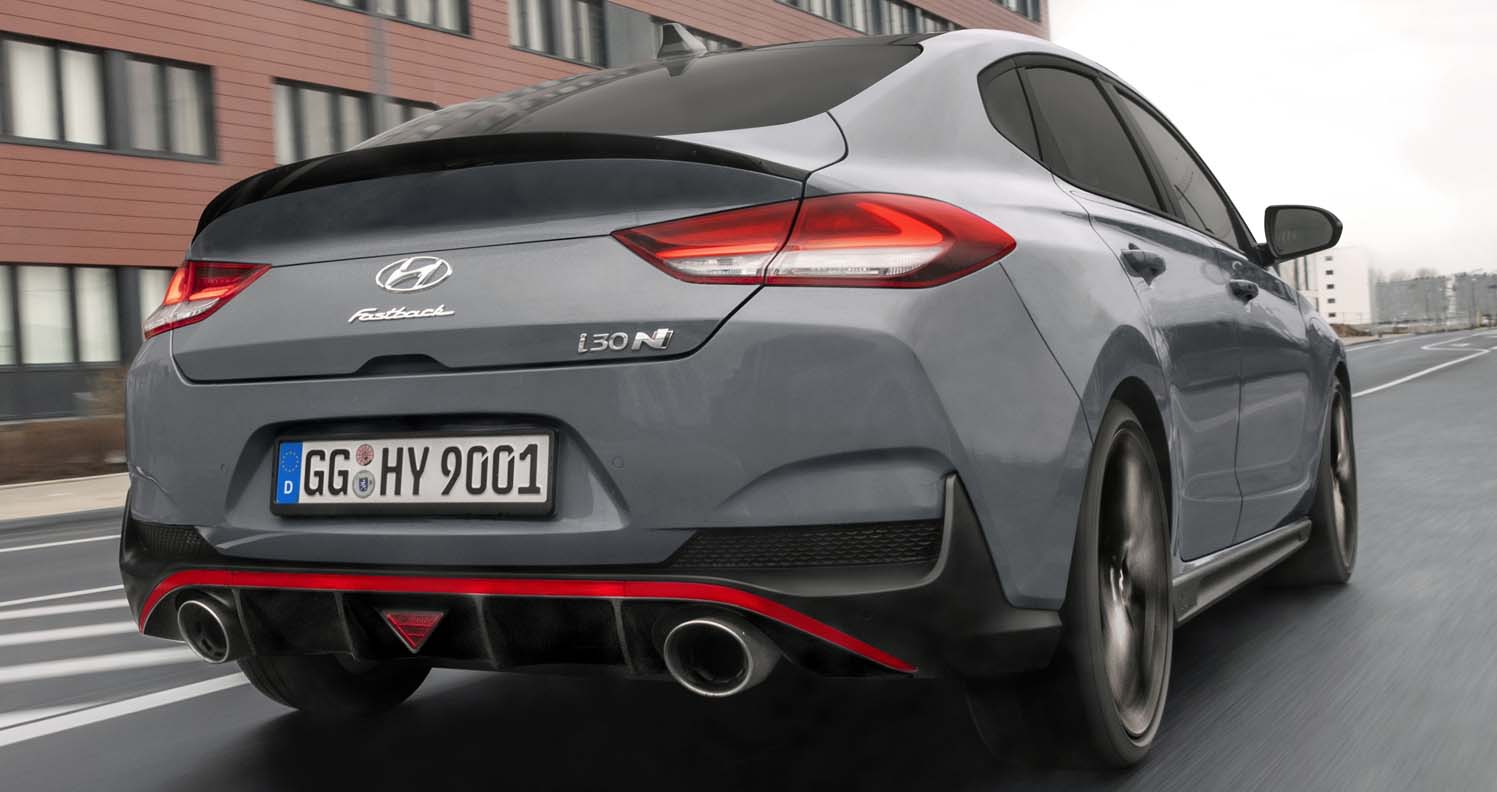
Exterior colours:
- Performance Blue
- Polar White
- Engine Red
- Sunset Red Pearl
- Shadow Grey
- Dark Knight Grey Pearl
- Phantom Black Pearl
When outfitted with the Performance Package (see below), the new i30 N comes with newly-developed 19-inch forged alloy wheels. The lightweight, optimised, five-double-spoke wheels were designed for minimum unsprang mass and high strength. The new i30 N is the first Hyundai mass production car to come with 19-inch forged wheels. Together, they are 14.4 kg lighter than the previous 19-inch casted alloy wheels. Their dark satin grey matte finish, contrasting with the N specific red brake callipers with N logo, underlines the racing spirit of the car. The new i30 N with Performance Package has also been outfitted with Pirelli P-Zero high-performance Hyundai N tyres. These were developed especially for the i30 N and feature an “HN” mark, which stands for “Hyundai N”, on the rims.
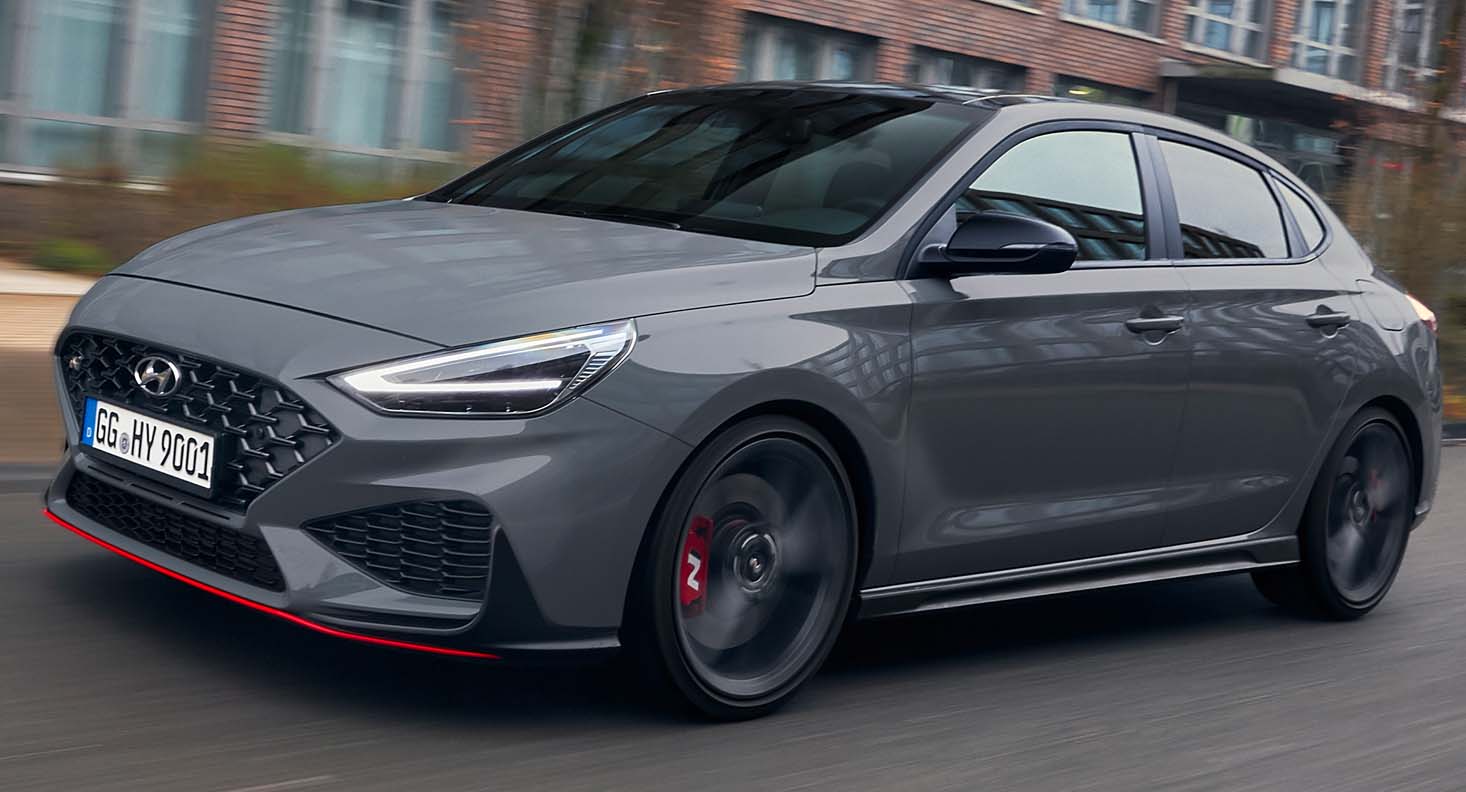
Interior Design
The interior of the new i30 N is focused on connecting the driver with the car at all touch points. The concept is dedicated to the people who truly love cars. The exclusive “N” steering wheel ensures that the driver is in 100% control of all driving performance features directly by hand. On the left side of the steering wheel, drivers can select three standard drive modes: Normal, Sport and Eco. On the right, the driver has direct access to the chequered flag N button for the N mode, or the customised setting which is visible on the N unique cluster. For better engine control during gear shifting, drivers can activate the Rev Matching control system by using the dedicated activation button just above the N button. The steering wheel is manufactured with the N unique blue stitching and garnished with an N logo at the bottom. The gear shift also features a unique blue stripe as part of the coherent colour design. On top, the ball-type knob bears the N badge.
The analogue cluster includes features such as the active variable LED red zone, which varies according to engine oil temperature, and the shift timing indicator, which shows the driver the best time to switch gears. Both the rev-counter and the speedometer are distinctively designed in accordance with the N line-up, being surrounded by a blue lightning line. The new i30 N is also available with a heated steering wheel and heated front seats.
The new Hyundai i30 N features sporty, metal pedals and Performance Blue stitching on both body types. The interior comes in one-tone Black with full cloth seats, or the option of artificial suede and leather seats.
N Light Sports Bucket Seats
The new i30 N was the first Hyundai N model to introduce the option of N Light Sports Bucket Seats, a set of lightweight, high-performance front seats with an illuminated N logo on an integrated headrest for a high-quality feeling. These uniquely-designed monoform high-performance sport seats are 2.2 kg lighter than the standard seats. The pronounced bolsters offer excellent lateral and back support. N Light Seats are made of premium leather combined with Alcantara materials and come with Performance Blue stitching, an illuminated N logo on an integrated headrest and seatbelt metal garnish for a high-quality feeling. N Light Seats are exclusive to the new i30 N and are available in Alcantara and leather.
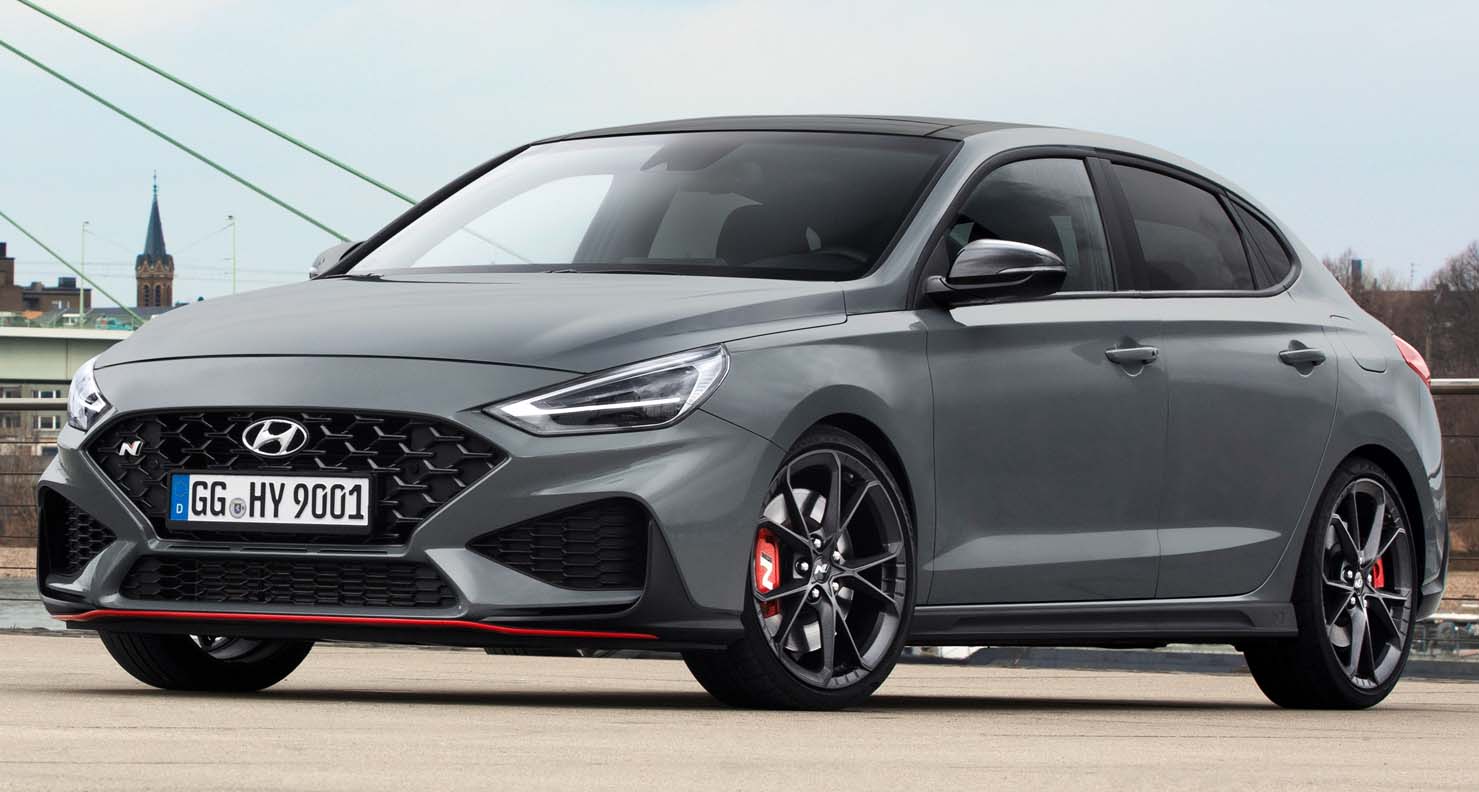
Powertrains
The new Hyundai i30 N is powered by a four-cylinder 2.0-litre turbocharged engine with front-wheel drive and either a six-speed manual transmission (6MT) or – for the first time – an eight-speed dual-clutch transmission (N DCT). The engine is available with two power outputs: standard trim and Performance Package. The standard trim engine with 6MT delivers a maximum power output of 250 PS and a maximum torque of 353 Nm. With the Performance Package, the engine delivers 280 PS. This is an increase of 5 PS from the original i30 N, and is available with both 6MT and N DCT. The maximum torque for the Performance Package variation has been increased by 39 Nm to 392 Nm.
The 280 PS engine offers flat power, which ensures high responsiveness and improved acceleration for even more fun on the road or on the racetrack. Flat power provides more torque and power at lower RPMs, thus utilising more of the engine’s potential in everyday driving situations. The new i30 N keeps maximum torque between 2,100 and 4,700 RPM, and achieves maximum power between 5,500 RPM and 6,000 RPM. This improves acceleration in the mid- and high-speed range and delivers a consistently high performance even in a variety of ambient conditions.
Both trim levels have a maximum speed of 250 km/h, and the new i30 N with the Performance Package and 6MT can go from 0-100 km/h in 5.9 seconds, an improvement of 0.2 seconds or 3 per cent as compared to the previous model. The new i30 N with the Performance Package and N DCT, meanwhile, can accelerate in only 5.4 seconds using Launch Control. With standard trim, the new i30 N can go from 0-100 km/h in 6.4 seconds.
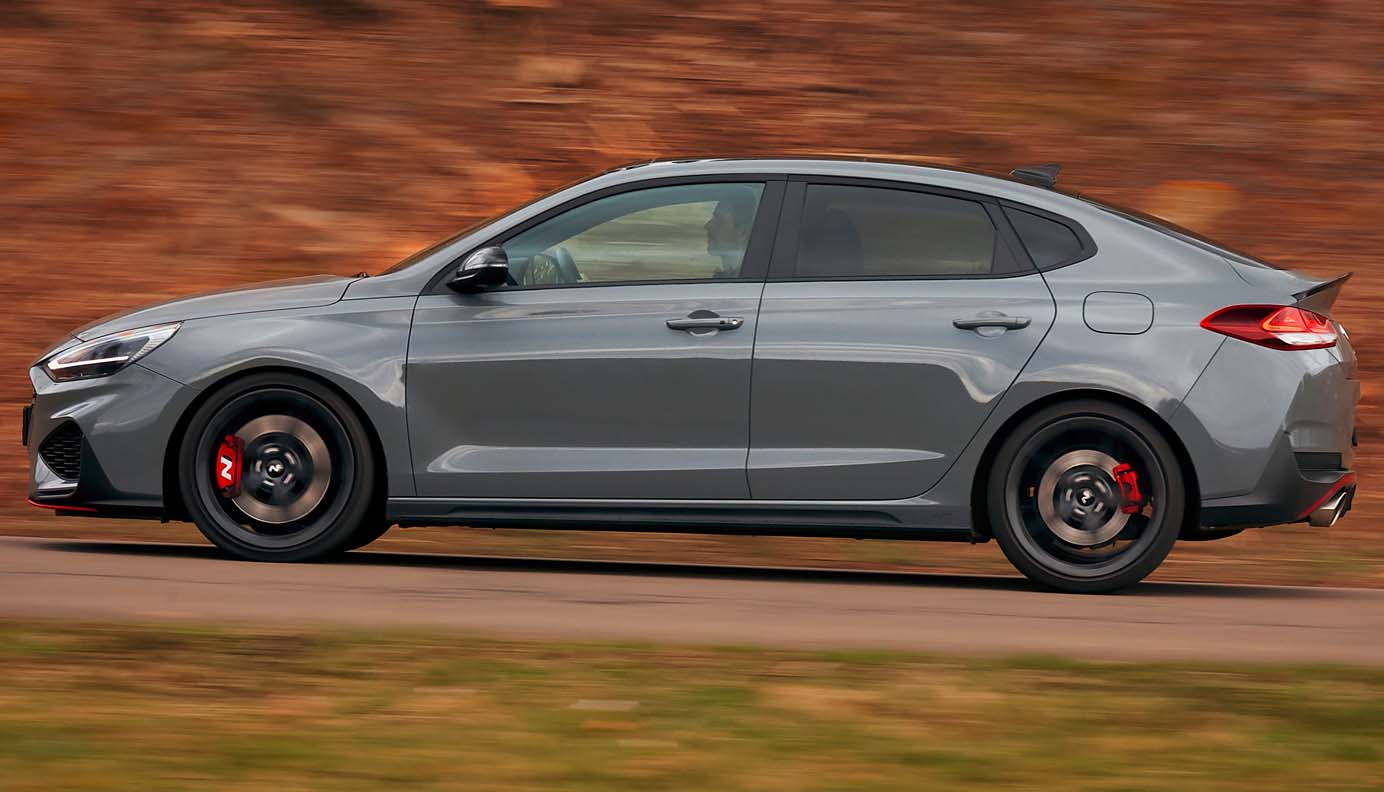
N DCT
The new N DCT eight-speed dual-clutch transmission enables a range of high-performance driving features, making the new i30 N even more fun to drive. N DCT provides the engaging experience of a sequential gearbox with the convenience of an automatic transmission.
N DCT is the enhanced version of the company’s in-house developed 8DCT, an eight-speed wet-type dual-clutch transmission. To make it suitable for N models, the 8DCT received improvements in durability, allowing it to handle the demands of high-performance vehicles. With the 2.0-litre T-GDI engine, it gives the best performance by applying unique gear ratios. The transmission control unit is calibrated for N, resulting in faster shifting and enabling a range of exclusive driving features.
Hyundai’s N DCT technology was first offered in the VELOSTER N, a model available in North America and Korea, and came to the new i30 N as a result of the valuable feedback of the Hyundai N community. Hyundai will also specify all units of the all-new KONA N with N DCT.
The wet-type N DCT is structurally similar to a manual transmission, making it similarly efficient at power delivery and shifting response. As opposed to a dry-type gearbox, the wet-type DCT uses two electrical oil pumps to reduce the amount of friction between the moving parts and for a better cooling of the clutch, thus allowing a higher amount of torque to transfer through the gearbox.
The electric pump system is composed of the High Flow Electric Oil Pump, which is responsible for gear lubrication and clutch cooling, and the High Pressure Electric Oil Pump, which supplies oil to the accumulator and maintains the pressure needed to control the gear shifting. Together, they ensure that the wet DCT can function with minimum engine power loss, thus resulting in better fuel economy as a welcome side effect. This new, updated pump system increases the number of applications for the wet N DCT, making it optimal for high-torque applications. The benefits are twofold: This system results in improved performance by increasing the maximum torque allowance, and the vehicle is more fun to drive due to increased power transmission efficiency and acceleration performance.
In addition to its increased performance, the application of N DCT also improves driving dynamics. The coolant oil consistently keeps the clutch at the optimum operating temperature, preventing overheating during high-performance driving when the car is being pushed to its limits. However, even on congested roads or steep inclines where the transmission undergoes increased exertion, N DCT will guarantee a smooth and stable journey.
The new Hyundai i30 N with N DCT also offers drivers the option to switch to real manual mode using the paddle shifters or the gear knob. The memory logic will prevent the transmission from automatically upshifting when the RPM limit is reached. That way, manual control allows the driver to sustain high revs when needed for an even sportier driving experience.
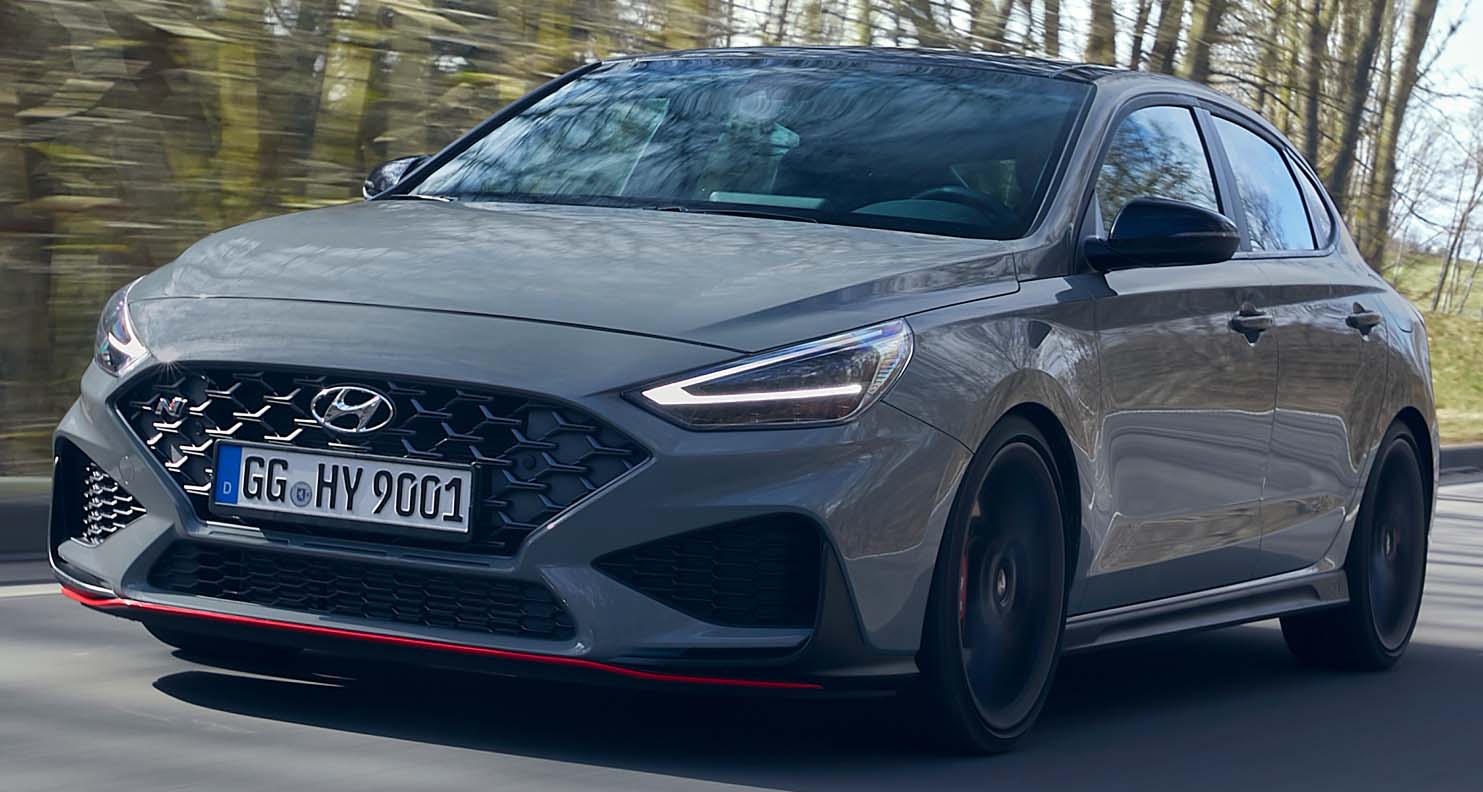
N DCT completes extensive test program
N DCT was tested on the legendary Nürburgring-Nordschleife for approximately 1,350 laps for durability alone during its development phase. The wet DCT was optimised for top endurance in order to handle the demands of high-performance vehicles.
The iconic Nürburgring racetrack is known as one of the world’s most challenging racetracks. With 73 corners and 20.8 kilometres of tarmac, it is also a motorsport complex and home to Hyundai’s own testing centre. Hyundai’s accelerated durability tests are conducted there. Each car taking part in these tests laps the Nürburgring at least 480 times (10,000 km) in both dry and wet conditions, simulating up to 180,000 km of severe driving in just five to six weeks. The constant combination of hard acceleration, rapid deceleration, and heavy cornering push the vehicles to their limits, and the variable surfaces and camber ensure top performance even in adverse conditions.
N performance functions: N Power Shift, N Grin Shift and N Track Shift
The N DCT enables exclusive high-performance functions that are sure to bring a grin to the driver’s face: N Power Shift, N Grin Shift and N Track Sense Shift. These features enhance the car’s capabilities by using a dedicated shift logic management.
N Power Shift (NPS) engages when the car accelerates with more than 90 percent of throttle, thereby mitigating any reduction in torque during upshifts to deliver maximum power to the wheels. This enhances fun to drive by giving a “push feel” when upshifting. The accompanying bang sound coming from the partial cylinder cut of the exhaust underlines the sporty performance.
N Grin Shift (NGS) maximises engine and DCT performance for 20 seconds. In order to get maximum acceleration, the car will directly shift down to the most appropriate gear. To activate, the driver pushes a dedicated button on the steering wheel, and a countdown begins on the cluster showing the remaining seconds for this function. After the “boost” has ended, drivers must wait at least 40 seconds to use it again. This feature allows the driver to use the full potential of the car with only one button – for example, when chasing for the best lap time. It can also be a benefit when overtaking or merging on a highway.
Finally, N Track Sense Shift (NTS) optimises adaptive shift for racetrack driving, helping the driver to focus more on the steering. It recognises when the conditions are optimal for dynamic driving on a racetrack and activates automatically. Based on motorsport data combined with the driver’s behaviour, the car selects the right gear and shift timing in sport driving conditions to provide optimal performance, just like a professional race car driver.
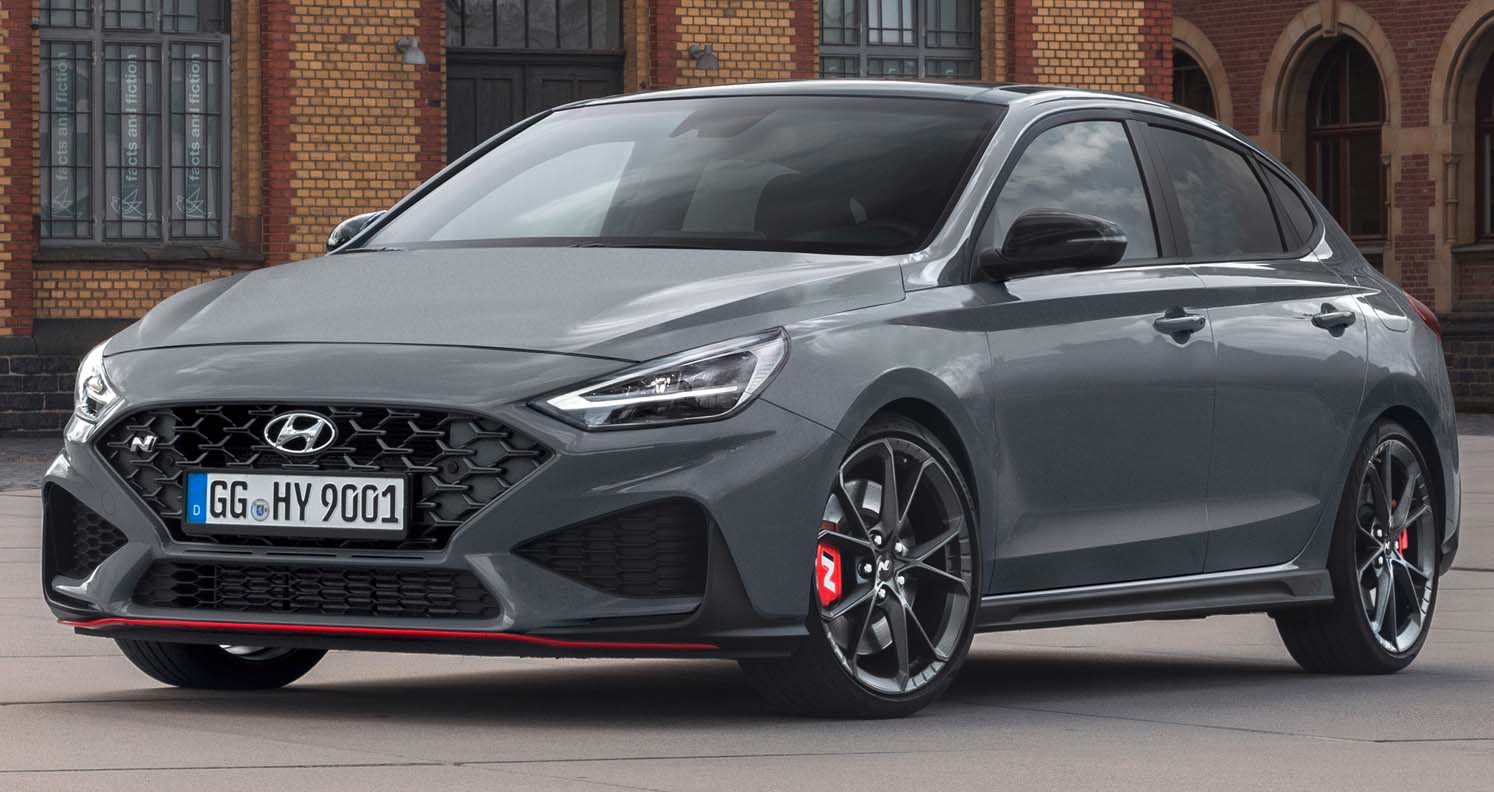
N Grin Control System
As with the first generation i30 N, the N Grin Control System gives customers the choice between five distinct drive modes: Eco, Normal, Sport, N and Custom. The drive modes change the character of the N by adjusting the operating parameters of the engine, Electronic Stability Control (ESC), exhaust sound and steering in order to optimise them for a variety of driving conditions. In Custom mode, drivers are free to customise the parameters to match their driving preferences and the road conditions. This is done via a “Spider diagram” on the Audio Video Navigation (AVN) screen.
Creep Off mode (with DCT)
Unlike with a traditional automatic transmission vehicle, in Hyundai vehicles with N DCT, the driver can choose to turn off the creep function. When the creep function is turned “off” and the car is in gear D, the car does not automatically roll when the brake pedal is released. Depending on the driver, this racetrack feature can also be useful to enhance comfort and convenience. Creep off mode can be activated or deactivated via the custom settings.
Electronic Sound Generator (ESG)
To provide the inside of the i30 N with a real high-performance experience, the sporty engine sound from the exhaust and intake noise of the car is supported by the Electronic Sound Generator in the body panel. In the cabin, an engine sound generator provides some extra acoustic drama to match the mood of the driver. ESG uses the windshield to transfer the sound into the car. Variable muffler control also contributes to the perfect exhaust sound. For the new Hyundai i30 N, ESG has been retuned to provide the perfect driving experience.
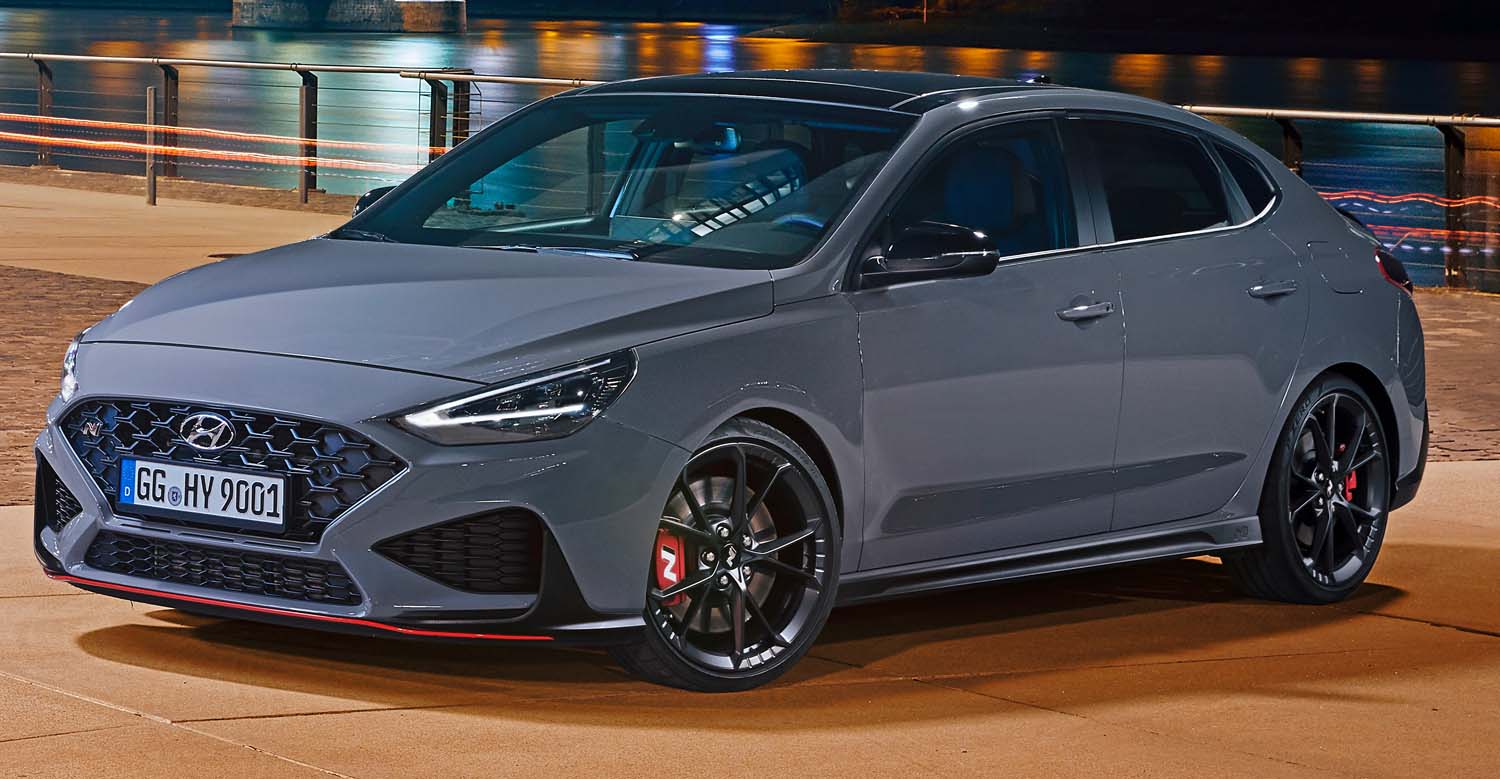
Launch Control (6MT & N DCT)
Launch Control boosts the car to its maximum power immediately upon launch. It can be activated in N mode with the Electronic Stability Control (ESC) switched off or in Sport mode. With 6MT, Launch Control can be engaged immediately by releasing the clutch pedal after full throttle acceleration pedal. It then allows the turbo to spool up before releasing the clutch pedal for the perfect start. Launch Control with N DCT regulates the amount of available engine torque when starting from the standstill, helping to launch the i30 N like a professional race driver with maximum traction and minimal wheel spin.
Rev Matching
Rev Matching automatically adjusts the revs of the engine when the driver shifts from a higher to a lower gear. Consequently, it allows smoother and sportier downshifts, depending on the drive mode. For the new i30 N with 6MT, Rev Matching can be easily switched on manually via a button located on the right side of the steering wheel. For the N DCT version, the Rev Matching function is on by default, so there is no need to push any button to activate it.
Variable Exhaust Valve System (with Performance Package)
Depending on the drive mode, the customer can adjust the exhaust sound and thus manage to actively control the exhaust valve. The sound differs with the size of the valve opening. The active exhaust has several settings, allowing the car to increase the volume of the exhaust sound and giving the typical i30 N “bang” sound effect when upshifting.
Ride and Handling
With the new Hyundai i30 N, suspension and steering systems have been retuned, resulting in improved ride and handling performance for both transmission types. The new suspension settings include a -1.5 degree negative camber, new dampers, new springs, new bump-stops, and an adjusted kinematic layout. The weight saved through the high-performance N Light Seats and 19-inch forged alloy wheels results in better performance and handling for a more agile driving experience. Additionally, for the Performance Package, the front brake disc size has been increased from 345mm to 360mm for an even better better braking performance.
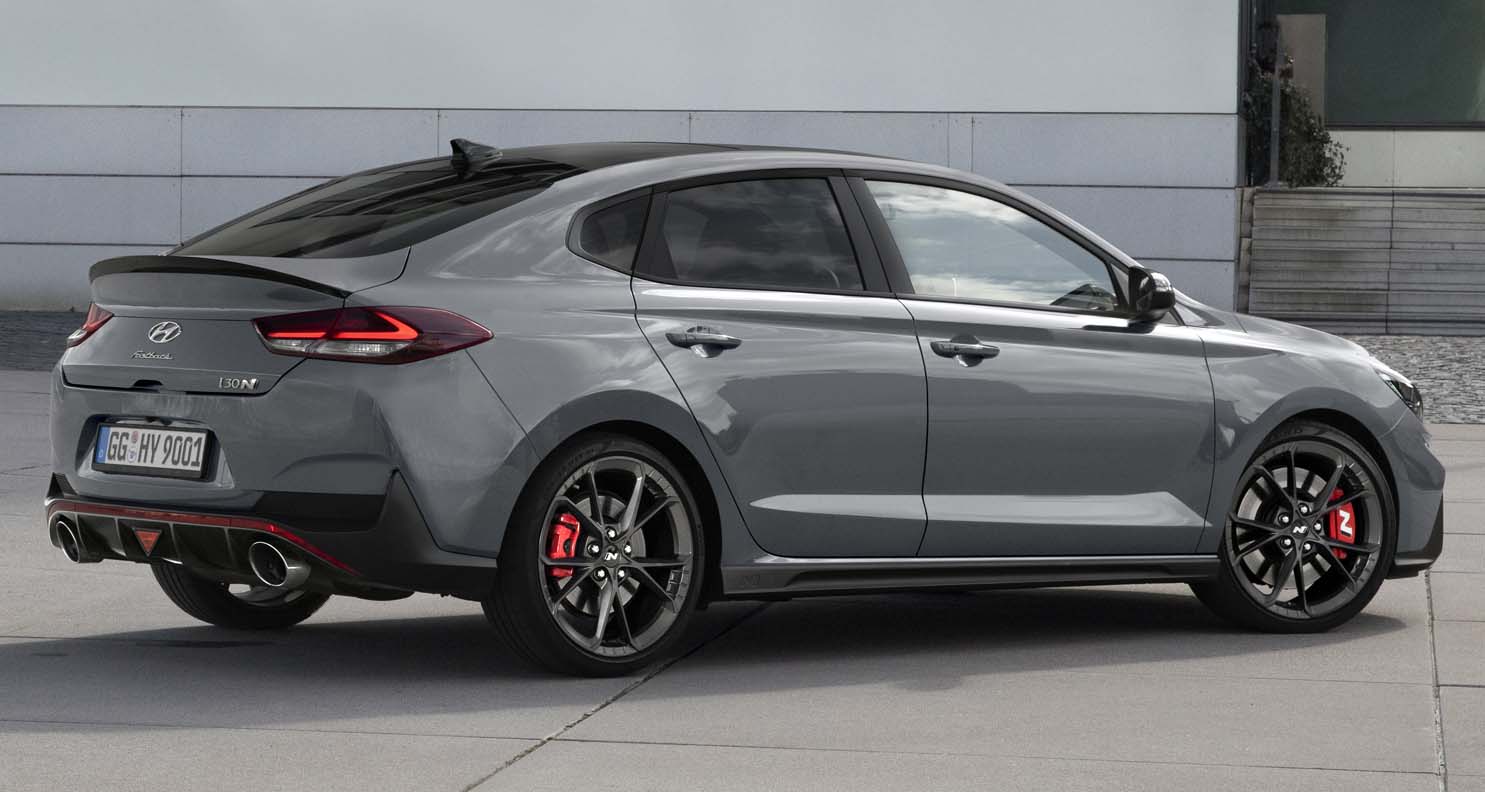
Electronic Controlled Suspension (ECS)
By controlling the damping force, ride and handling as well as stability are enhanced. Depending on the driving conditions, from daily trips to racetrack driving, the vehicle’s performance can be adjusted. The use of a solenoid valve guarantees a precise and immediate damping force control. It allows the driver to influence the stiffness of the suspension with the push of a button.
Electronic Stability Control (ESC)
The Electronic Stability Control (ESC) system stabilises the vehicle during cornering manoeuvres. For even sportier pleasure of driving, the Electronic Stability Control (ESC) can be operated in three stages: Normal, Sport, and off. When on, the system is optimised for daily driving, yet still allows for driving fun. Sport is optimised for dynamic driving and allowing for some slip-angle, or drivers can turn it fully off for the maximum racetrack feeling. The tuning philosophy is to enable the driver to drive Nürburgring-Nordschleife in Sport mode without any unwanted ESC interventions.
N Corner Carving Differential (with Performance Package)
The strong cornering ability of i30 N is achieved by different performance features, such as the N Corner Carving Differential, a type of Electronically-Controlled Limited Slip Differential (eLSD). N Corner Carving Differential is designed and engineered to provide a unique carving feel through even the most challenging corners. It allows driven wheels to turn at different speeds by applying different amounts of torque depending on the load transfer from the outer to the inner front axle wheel. Wheel slip in specific conditions is reduced and understeering on cornering minimised. N Corner Carving Differential enhances grip, increases the maximum cornering speed and driving fun through corners by delivering maximum power to the road.
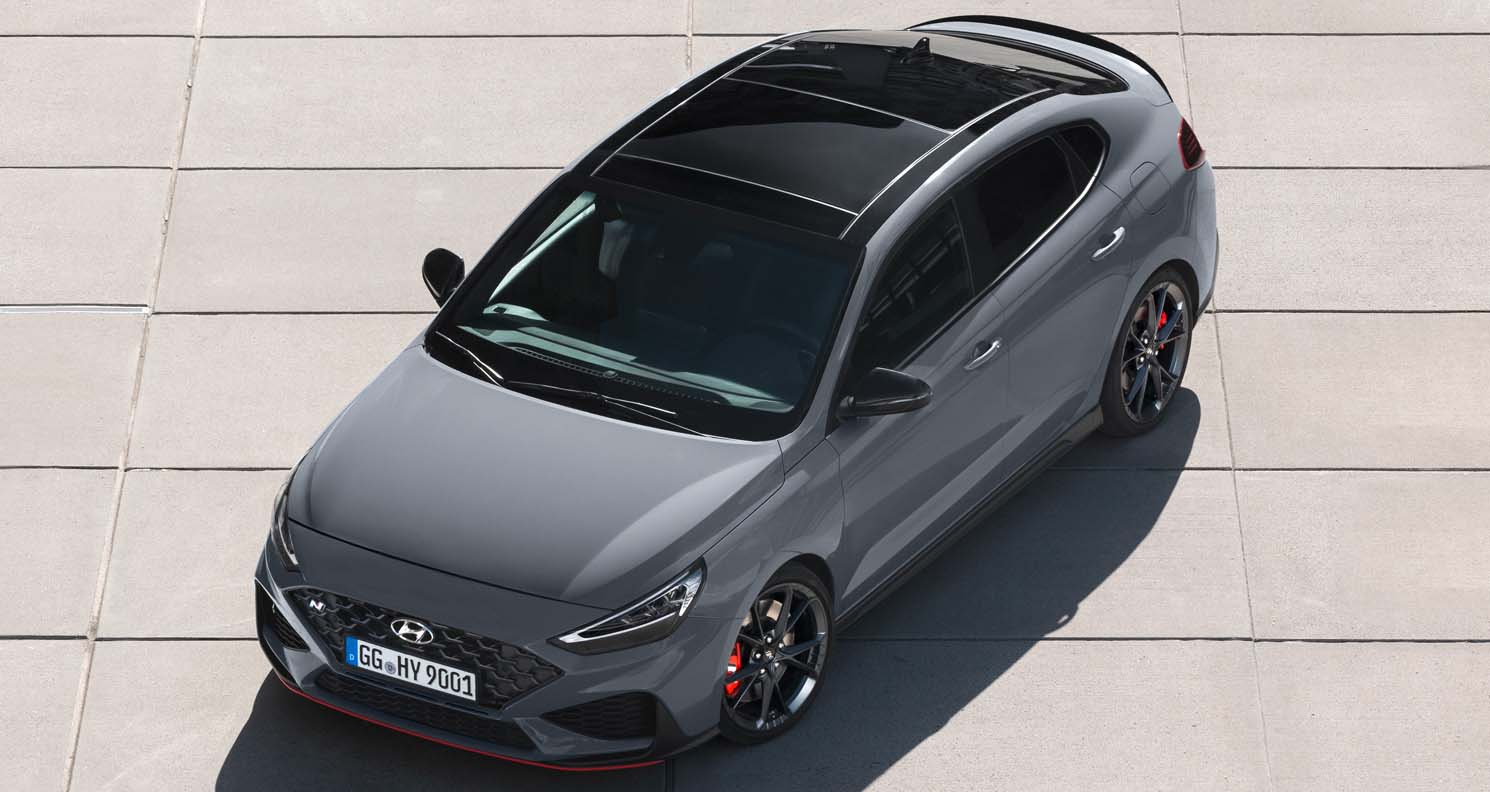
Rack-mounted Motor Driven Power Steering system (R-MDPS)
Hyundai N models offer a new level of precision and responsiveness in its steering, delivering great value to the driver: their Rack-mounted Motor Driven Power Steering system (R-MDPS) provides stability to the vehicle at high speeds and makes the car instantly responsive at lower speeds. While being integrated into the steering rack, the electric motor provides extremely direct feedback to the driver.
Safety
Hyundai N models are equipped with a wide range of the latest Hyundai SmartSense active safety and convenience features to comply with the highest European safety standards. This is an important aspect of the “everyday sports car” pillar: Not only are Hyundai N models racetrack capable, they are a convenient choice for everyday driving.
The new Hyundai i30 N has been upgraded to include more class-leading Hyundai SmartSense active safety and driver assistance features. Forward Collision-avoidance Assist has been upgraded to include pedestrian detection (FCA-P). Lane Following Assist (LFA) works to keep the vehicle centred in its lane even before the vehicle begins to drift to one side. Leading Vehicle Departure Alert (LVDA) alerts the driver when the vehicle ahead of them starts moving forward and they do not react quickly enough, for example at traffic lights.
The hatchback version of the new i30 N with N DCT comes with the option of Blind-Spot Collision-avoidance Assist (BCA-R). This function can activate the brakes to prevent a collision when switching lanes on the highway. Using radar, the Blind-Spot Collision Warning (BCW) monitors the rear corners and, if another vehicle is detected, a visual alert appears on the exterior mirrors. If the driver then activates the indicators, an audible signal is emitted. This also applies to lane change situations in which a vehicle is detected. Similarly, Rear Cross-Traffic Collision-avoidance Assist (RCCA), also available on the hatchback with N DCT, not only warns the driver if a vehicle approaches from the side when reversing out of areas with low visibility, it also automatically brakes when required. Meanwhile, Rear Cross-Traffic Collision Warning (RCCW) reduces the risk of collision with approaching traffic when reversing out of narrow areas with low visibility. Using a radar to scan a 180-degree area behind the vehicle for approaching cross traffic, RCCW alerts the driver visually and audibly.
As with other models in the Hyundai i30 range, the new i30 N offers the latest active safety and driver assistance features.
Hyundai SmartSense safety features:
- [NEW] Forward Collision-avoidance Assist with vehicle and now also with pedestrian detection (FCA-P)
- [NEW] Lane Following Assist (LFA)
- [NEW] Leading Vehicle Departure Alert (LVDA)
- [NEW] Blind-Spot Collision Warning (BCW) (hatchback only)
- [NEW] Blind-Spot Collision-avoidance Assist (BCA-R) (only DCT, hatchback only)
- [NEW] Rear Cross-Traffic Collision-avoidance Warning (RCCW) (hatchback only)
- [NEW] Rear Cross-Traffic Collision-avoidance Assist (RCCA) (only DCT, hatchback only)
- High Beam Assist (HBA)
- Lane Keeping Assist (LKA)
Another safety feature, eCall, can contact emergency services at the push of a button, and automatically contacts first responders if the vehicle’s airbags have been deployed.
Tech and Connectivity
The new Hyundai i30 N offers state-of-the-art connectivity. To empower the driver to become better with every ride, it features a Performance Driving Data System to monitor and improve the driver’s track skills, with updated graphics for even more ease of use. This feature saves and displays driving data, including information on PS, torque and turbo boost. It also includes a lap and acceleration timer, specially designed for racetrack driving.
The specific N mode screen menu also offers customisable settings for the engine, suspension, steering, differential (in the Performance Package), transmission Rev Matching, exhaust sound and stability control.
The new Hyundai i30 N comes with an optional 10.25-inch touchscreen navigation system with Apple CarPlay and Android Auto. It is also available with the latest version of Bluelink, Hyundai’s state-of-the-art connected car services. This offers a range of new benefits and services for Hyundai customers including Connected Routing, Last Mile Navigation and live parking information, and a new user profile feature. And The new i30 N is available with a wireless charging pad.
